Leading experience agency GR8 hosts the second annual, once-in-a-lifetime culinary experience “Once Upon A Kitchen,” featuring unique creations from the world’s top chefs.
For the first time ever, four culinary masters — Massimo Bottura, Joan Roca, Mauro Colagreco, and Christina Tosi — came together under one roof to curate an exceptional multi-course dinner. Often inspired by the world’s artwork, people and history, each chef showcased original culinary creations on the evening of December 5, at New York City’s Gotham Hall. Unique Homes was honored to attend.
Whether it was the beetroot cooked in salt crust, spin-painted veal, or deconstructed apple pie, those who attended this exclusive gastronomic experience savored inspired dishes while indulging in exclusive wine.
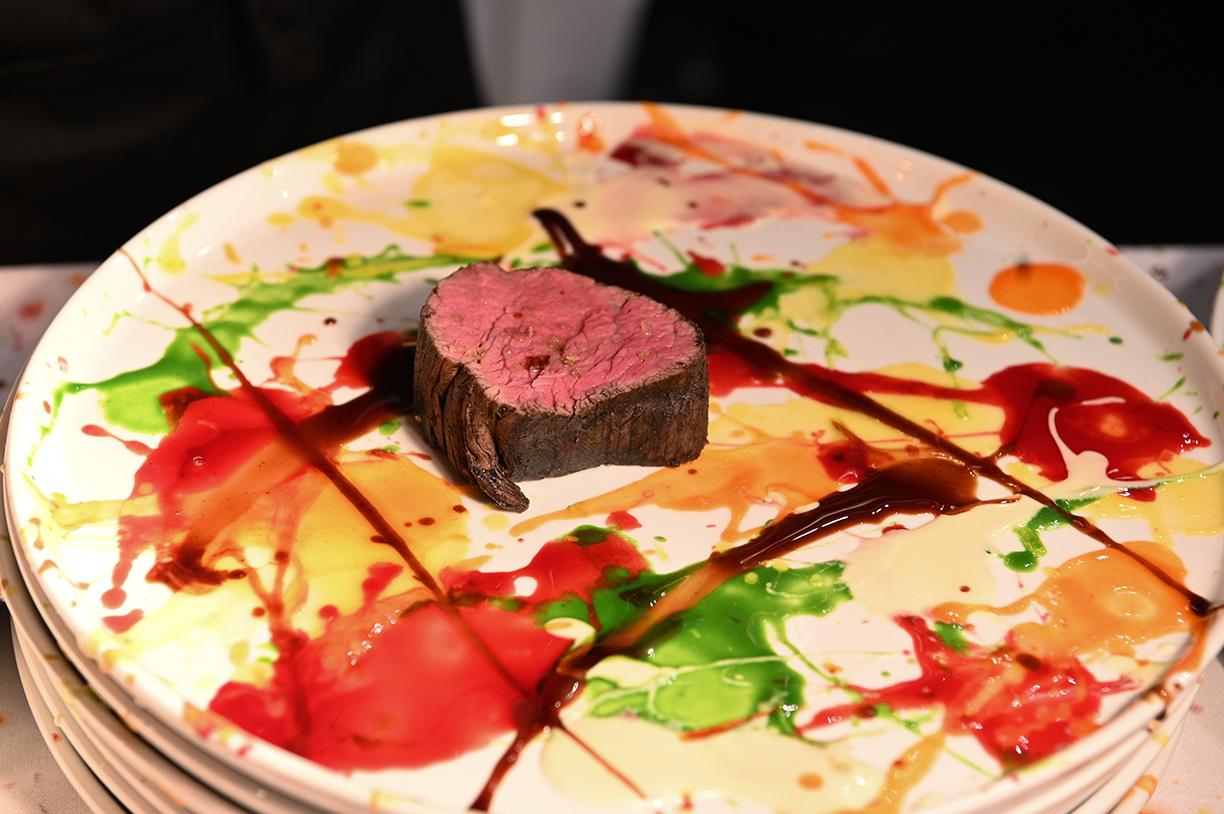
“Psychedelic Spin-Painted Veil” by Massimo Bottura
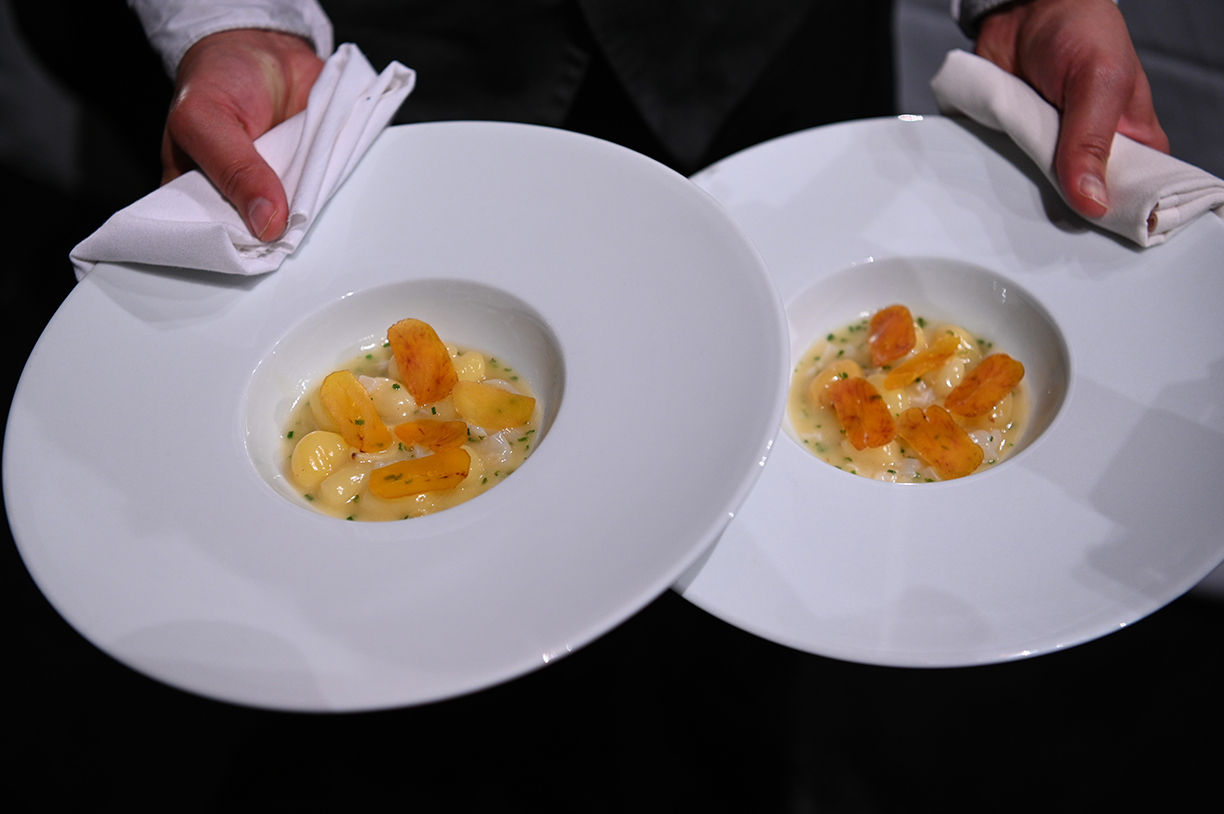
Ragout of Baby Potatoes.
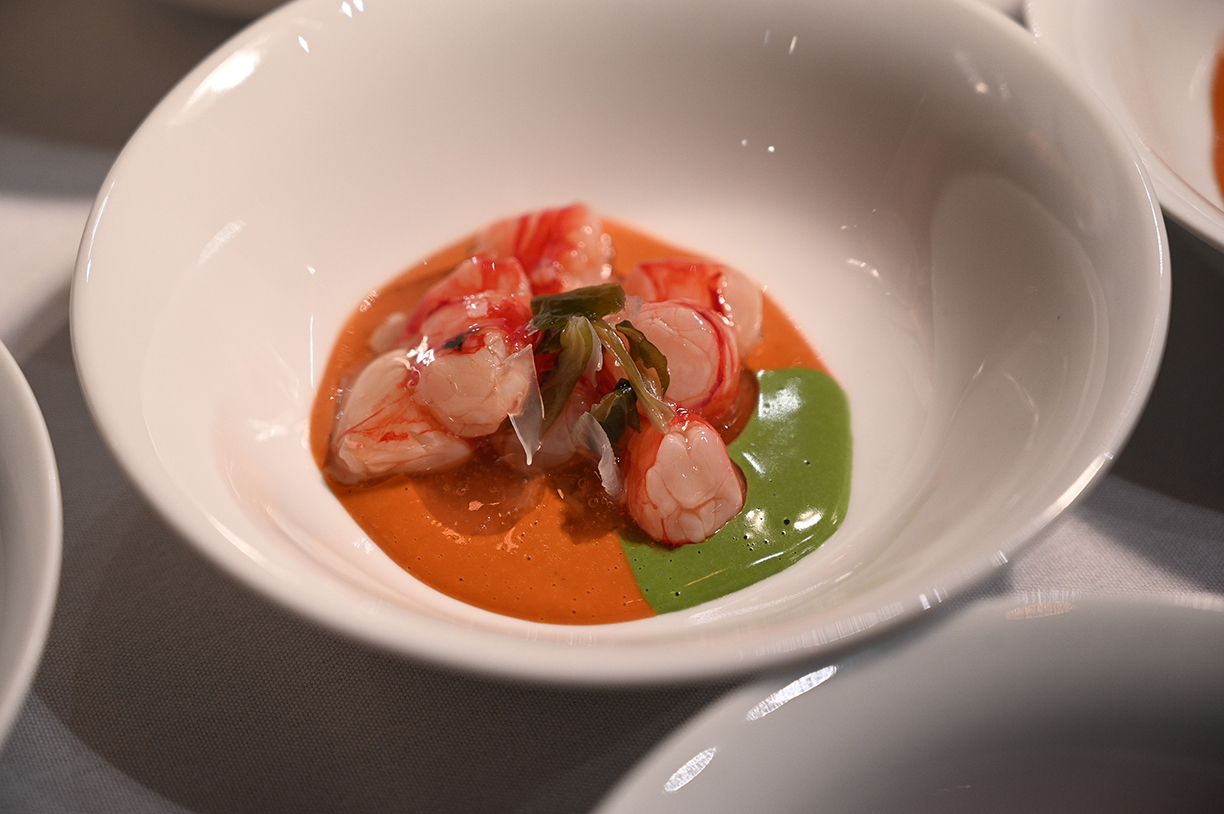
Prawn Marinated with Rice Vinegar
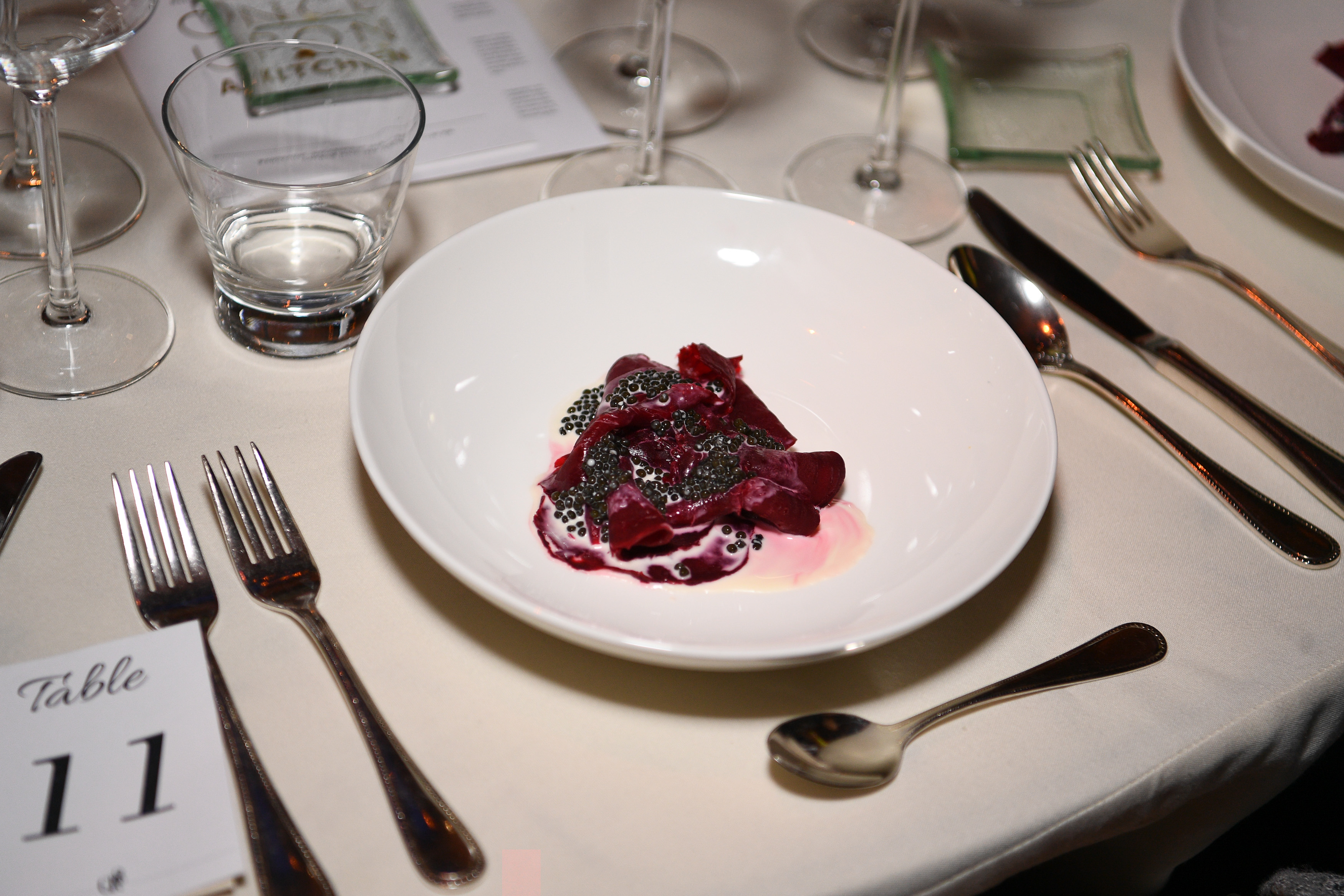
Beetroot Cooked in Salt Crust

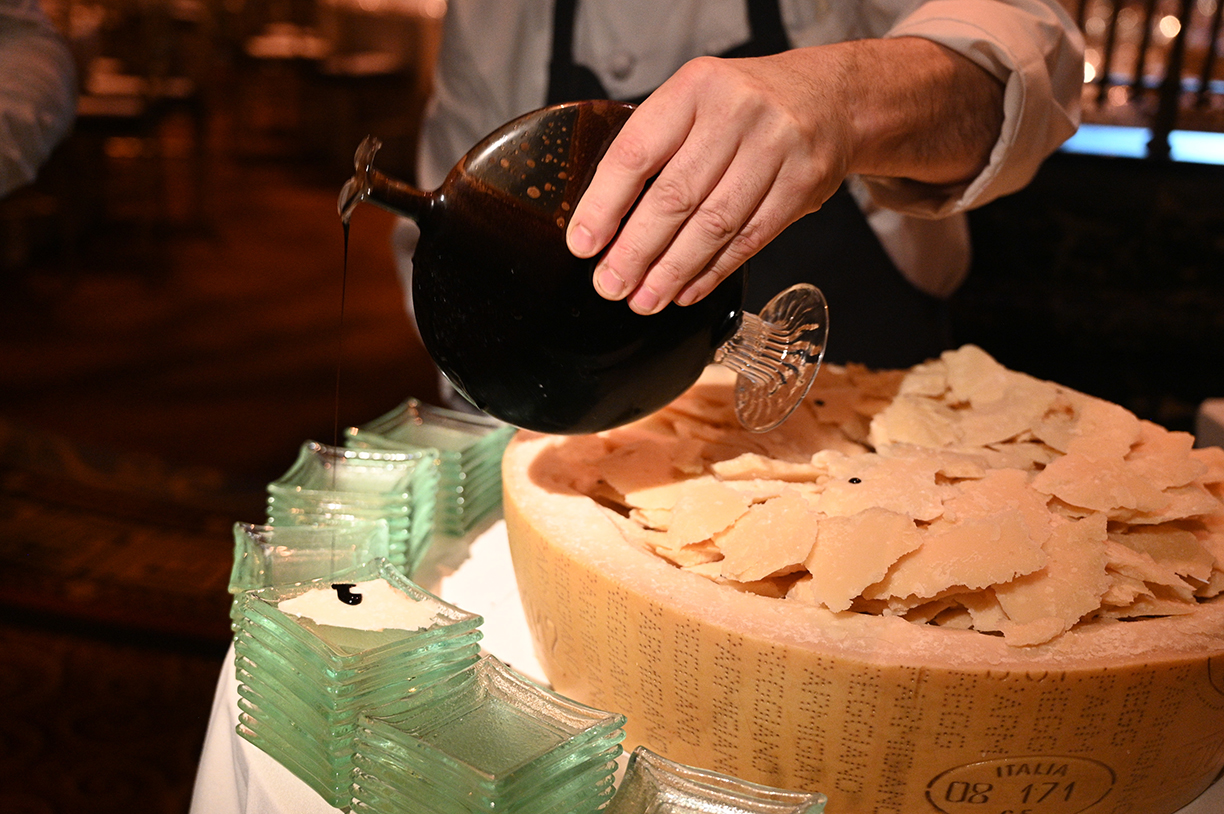
The evening commenced with the Eureka Experience, a private wine tasting with world-renowned winemaker Roberto Cipresso. Attendees were presented with two exquisite wines coinciding with stories from two iconic regions of Italy, Tuscany and Lazio.
Guests were then welcomed to a cocktail reception, which highlighted three unique wines and one signature cocktail paired with hors d’oeuvre creations from each chef.
Massimo Bottura presented a 30-month selection of Parmigiano Reggiano with extra aged balsamic vinegar, along with Mauro Colagreco’s Jerusalem artichoke tartelettes with black trumpets and melanosporum truffle and Joan Roca’s Steamed Truffle Brioche.
Following the hors d’oeuvres, attendees were seated and addressed by CEO of GR8, Barnabas Carrega, and award-winning creator and host of The Sporkful podcast, Dan Pashman.
Pashman was the official host of the evening, presenting the chefs and each of their exclusive dishes. Serenaded by an accompanying pianist, guests watched as the chefs prepared, cooked and plated seven courses in total — each accompanied by a hand-selected wine.
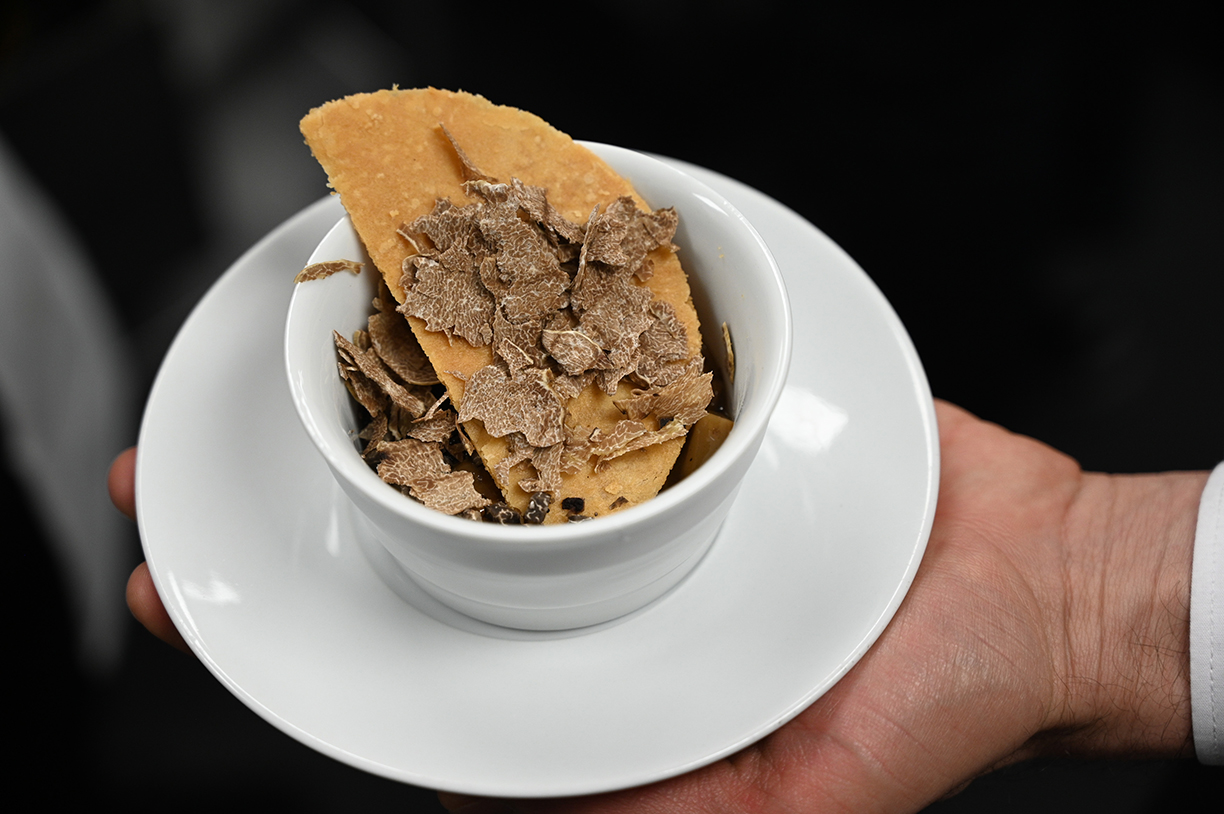
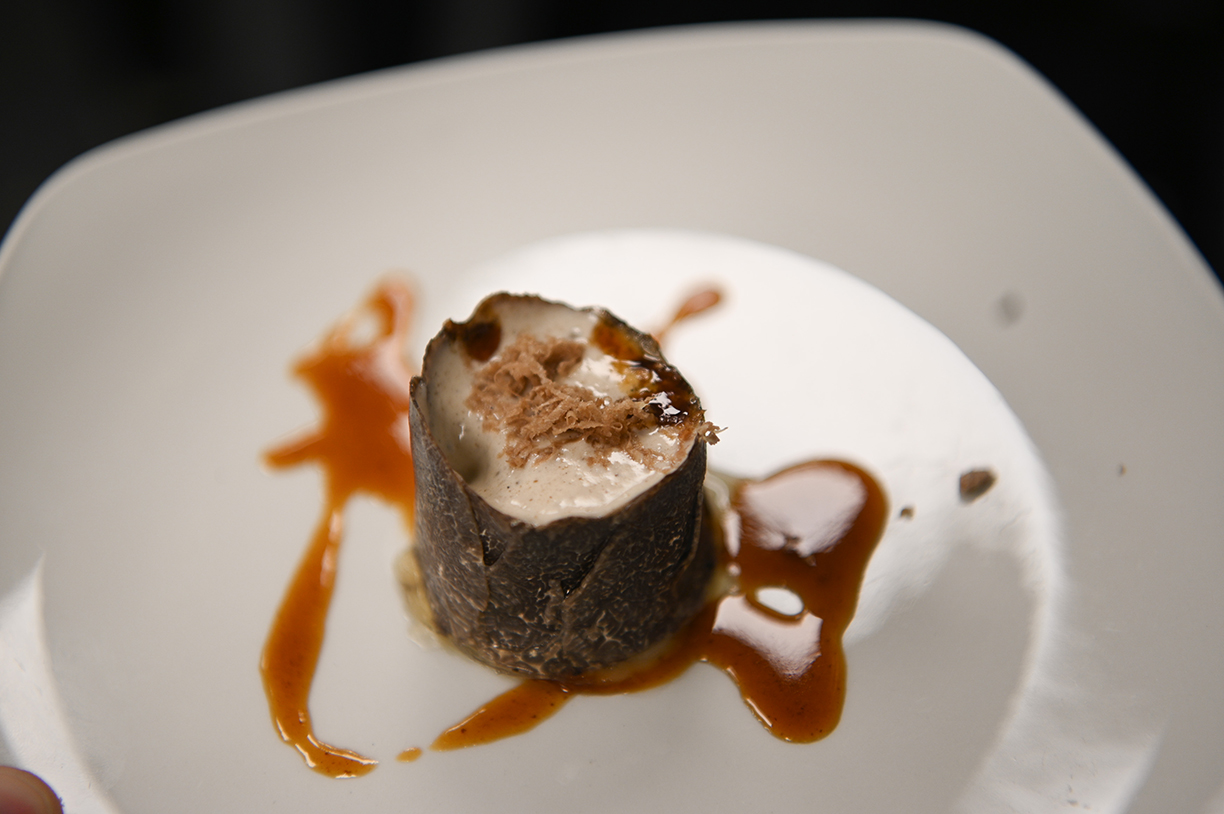
Left: “Never Stop Planting” by Massimo Bottura
Above: Truffle Soufflé with Veal Oyster Blade by Joan Roca
Some culinary highlights of the evening came from Osteria Francescana’s Massimo Bottura who presented a “Never Stop Planting” dish paying tribute to Joseph Beuys’ infamous installation planting oak trees and granite columns throughout far reaching locations.
The dish was a foie gras custard served with seasonal woodland flavors from truffles to mushrooms in a mineral broth. Bottura also presented guests with “Psychedelic Spin-Painted Veil.” The meat was marinated in milk, brushed with vegetable charcoal and dressed with creamy potatoes, puree of orange and yellow peppers, a red beet reduction and extra old Villa Manodori Artigianale balsamic vinegar from Modena.
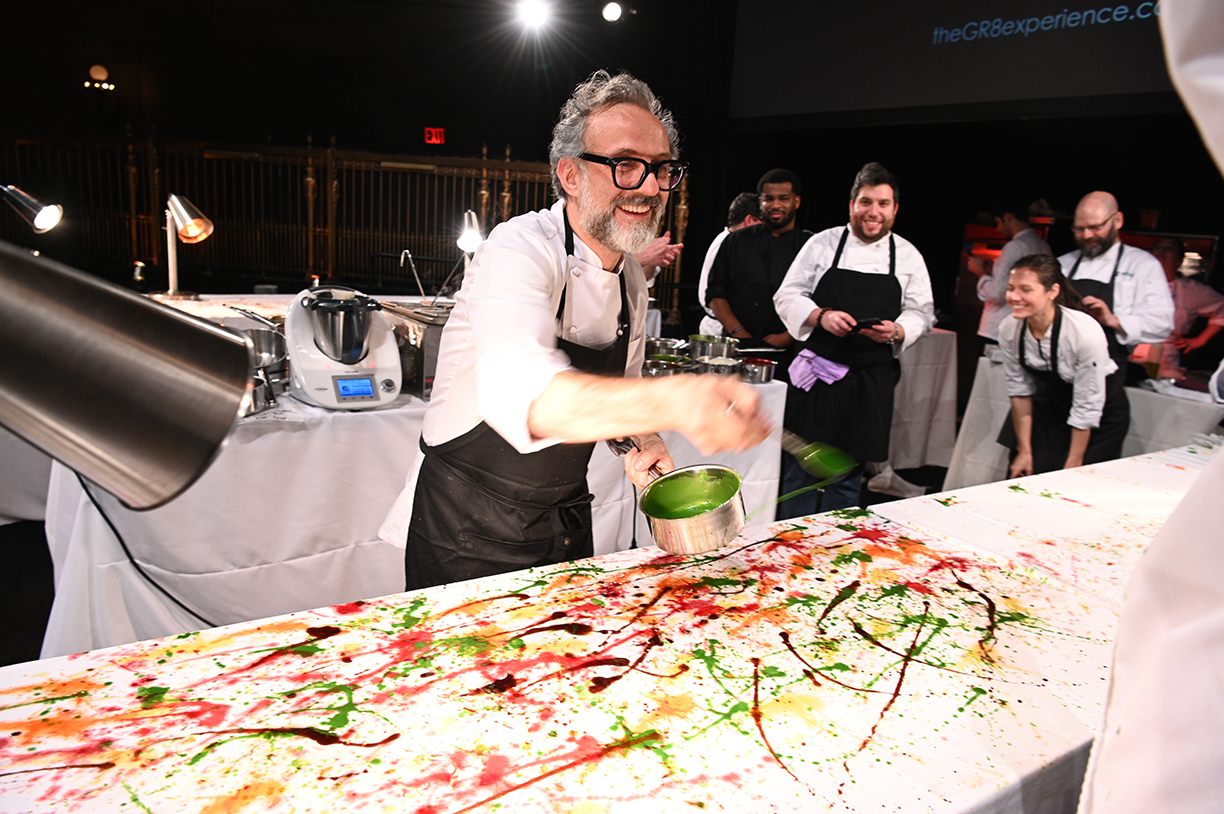
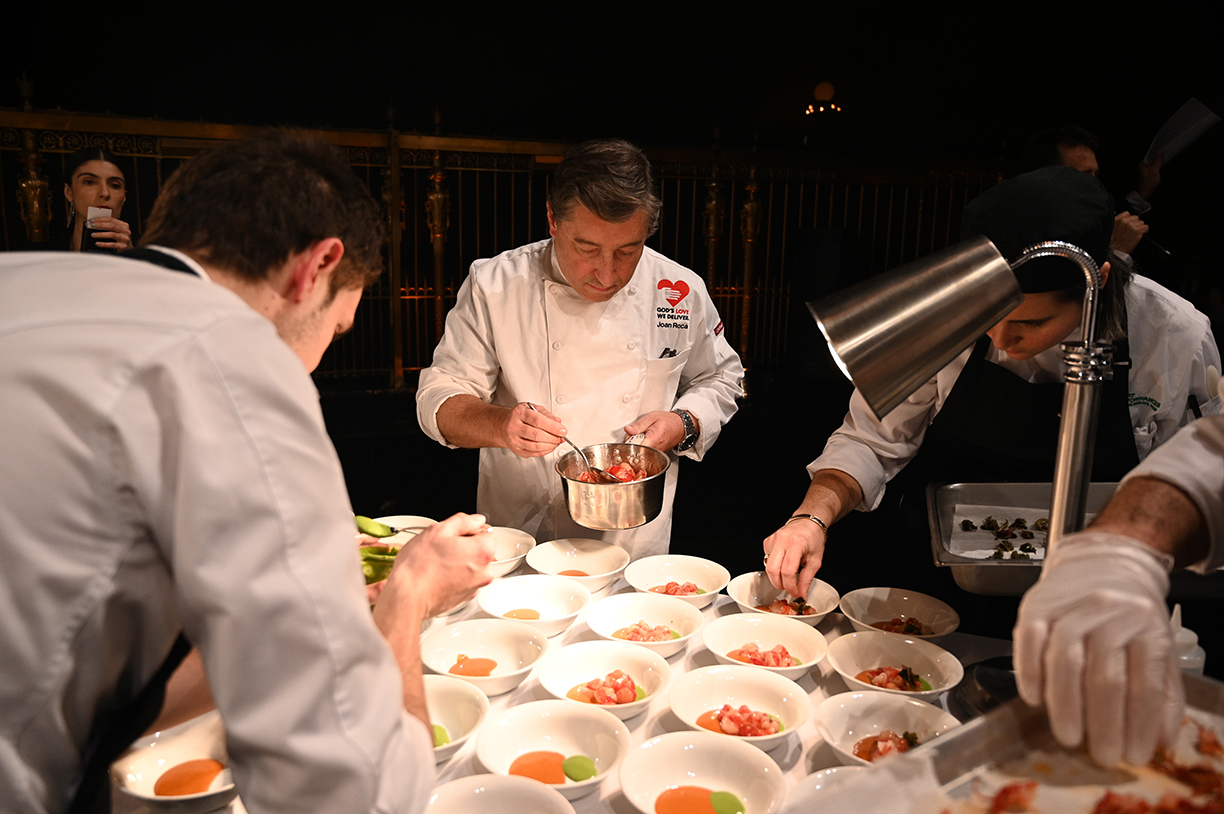
Joan Roca’s exquisite cuisine featured prawn marinated with rice vinegar, drawing inspiration from Salvador Dalí’s “The Persistence of Memory.” Roca also presented a truffle soufflé with veal oyster blade inspired by Gaudi’s modernist architecture and the “Melting Watches” of Dalí’s famous painting, “The Persistence of Time.”

Mauro Colagreco showcased his undeniable talents through a “Crapaudine” Beetroot cooked in salt crust, finished with a “Ossetra” Caviar Sauce inspired by the agricultural knowledge of producer, Annie Bertin from the small town, Vende, in northwestern France.

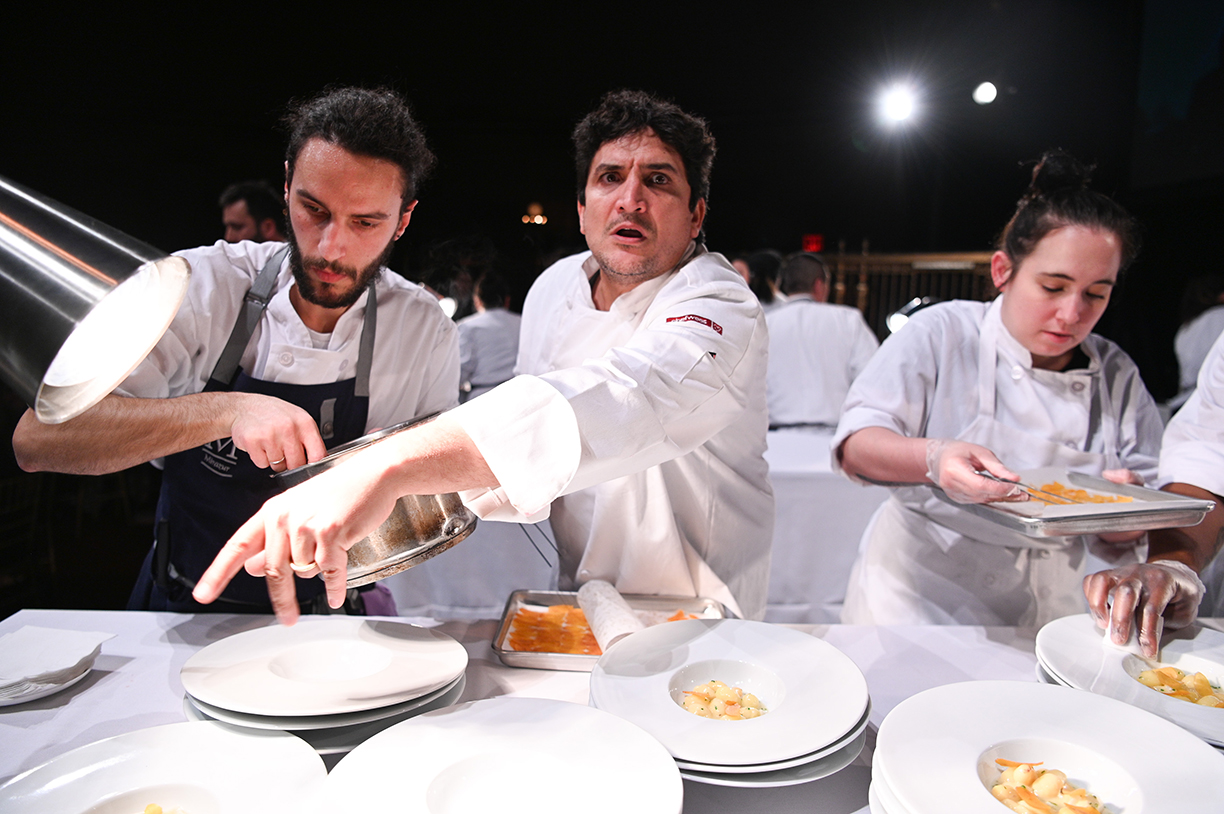
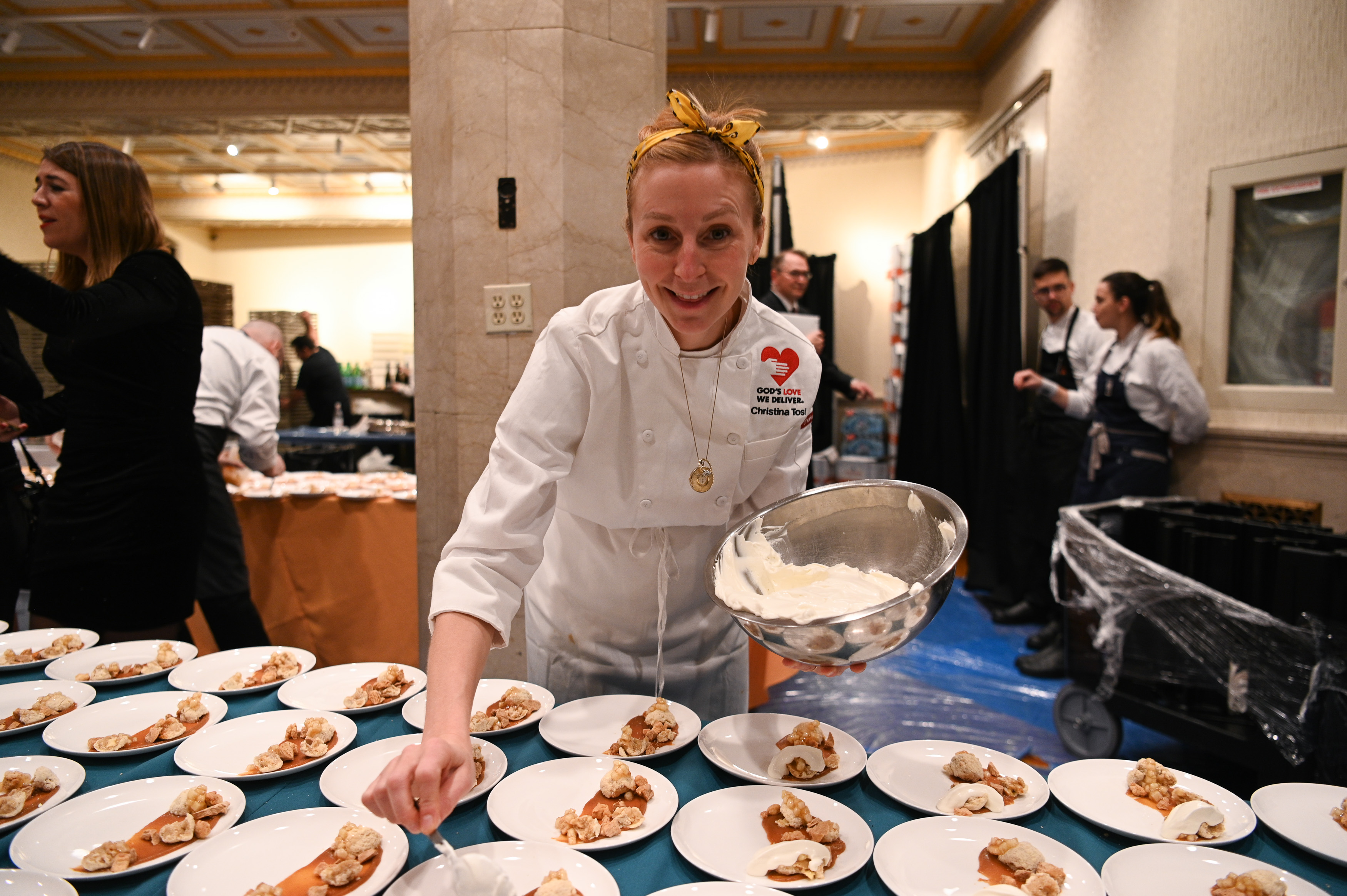
Guests were then treated by the creative mastermind and classically trained pastry chef Christina Tosi, founder and CEO of Milk Bar, whom presented an exclusive “Apple Pie-ish” dessert topped with a miso butterscotch, brown butter and sour whipped cream.
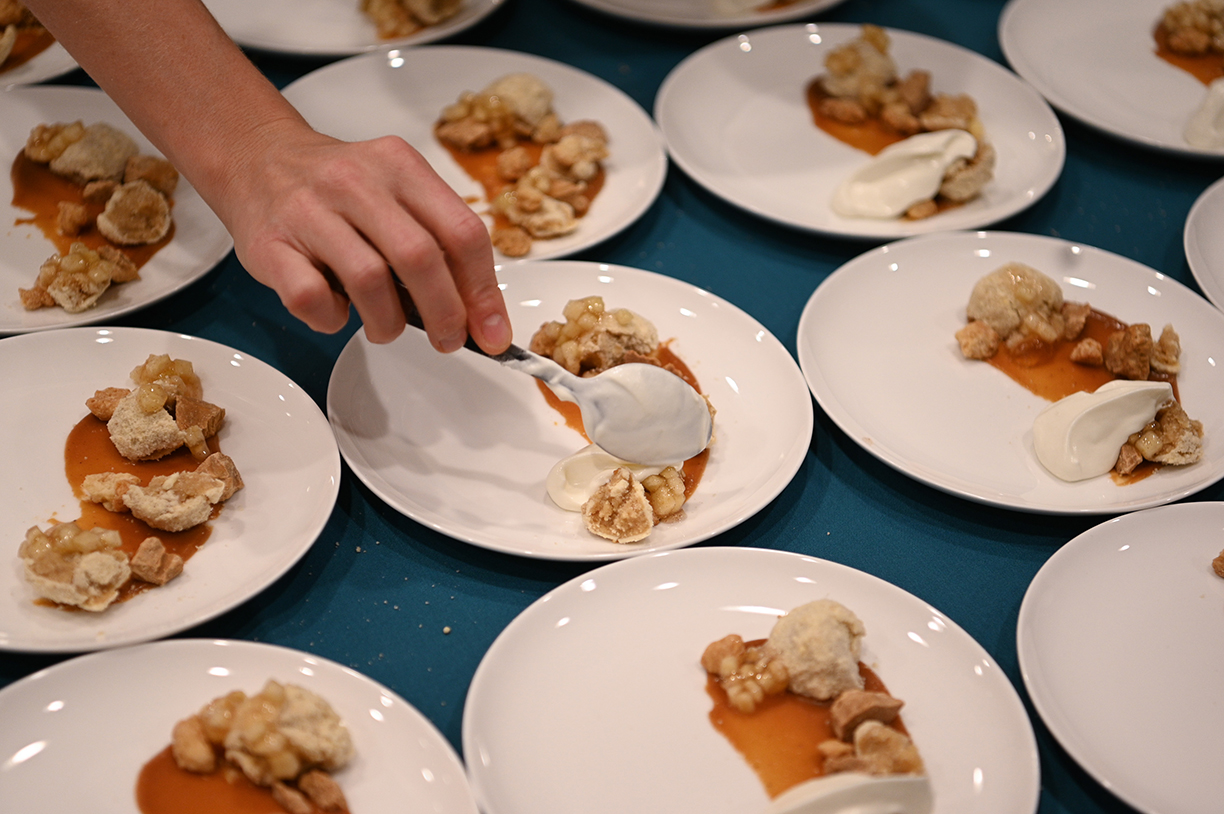
Following the gastronomic cuisine, all four chefs came to the stage for a final conversation with Dan Pashman discussing their dishes from the evening and the inspirations that created them.
The evening’s beneficiary was God’s Love We Deliver, the leading provider of nutritious and personalized meals to individuals who are too ill to shop and cook for themselves. God’s Love We Deliver creates and provides over 7,000 meals each weekday, delivering them to those with life-altering illnesses across all five New York City boroughs, Westchester and Nassau Counties, and Hudson County, New Jersey.
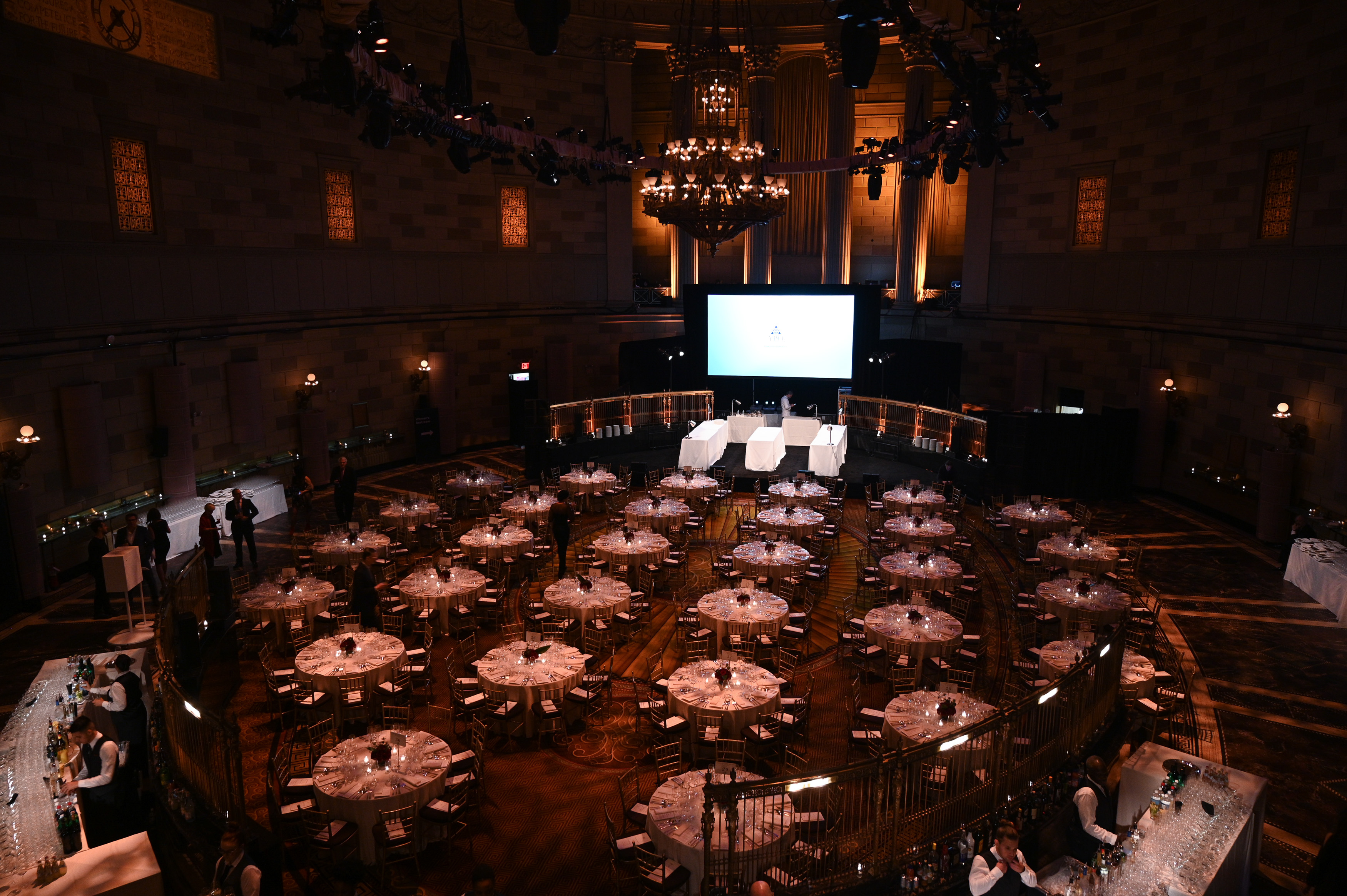

Photo courtesy Jack Oughton.
DUE TO THE EVER-CHANGING MOOD OF HIGH-END DINERS, HOTEL MANAGEMENT CONTINUES TO ADAPT TO NEW AND EXCITING CHALLENGES WITHIN THE FOOD AND BEVERAGE SECTOR OF LUXURY TRAVEL. IN A RECENT POST BY TEXAS MEETINGS + EVENTS, EXECUTIVE CHEFS AND MANAGEMENT MEMBERS DISCUSS TRENDS WITHIN THE WESTERN REGION OF US THAT ARE BECOMING UNIVERSALLY SEEN IN HOTELS ACROSS THE COUNTRY.
LOCAL SOURCING & AUTHENTICITY
“Traveling is all about experiencing a new culture, and that includes fare from the region guests are visiting,” says James Morin, executive chef at the Hyatt Regency Hill Country Resort & Spa located in San Antonio.
“We see a lot of guests enthralled by the culture of our Lone Star State, and they want to experience that unique Texas flavor in authentic cuisine.”
Showcasing the sourcing of ingredients and partnerships with local suppliers is a shift from previous priorities. The George R. Brown Convention Center also works to showcase its local partners by prominently featuring their branding in restaurant and café experiences, according to Chris Bupp, general manager of Levy, the exclusive food and beverage provider for the convention center.
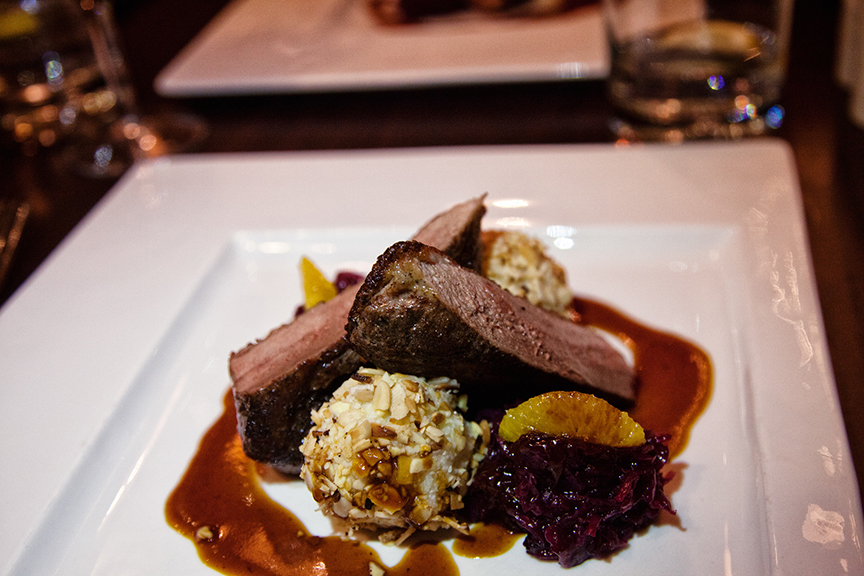
Photo by Jack Oughton.
One example of this is the convention center’s relationship with local company Java Pura as a coffee vendor. “In telling people about it, it’s roasted down the street and it’s available across Texas,” Bupp says. “What a great story to tell, and consumers love hearing about it.”

Photo by Vishnuvardan.
HEALTHY ALTERNATIVES & DIETARY RESTRICTIONS
Chefs at multiple hotels and resorts spoke about an increased desire to develop menus with healthy options for attendees. For breakfast, often groups are looking for healthy options and “light action stations,” as they “want to see how the food is prepared,” says Christof Syré, executive chef at the Four Seasons Resort and Club Dallas at Las Colinas.
In regards to particular ingredients, grains such as quinoa, farro and sorghum have gained a new spotlight, as well as cold oatmeal and avocado toast topped with smoked salmon or a poached egg. Salmon has been a strong ingredient for Ruffy Sulaiman, executive chef at Hilton Americas-Houston.
“When we do a lot of tastings, each time we have salmon in the tasting, salmon always wins,” Sulaiman says. He credits the interest in salmon because it’s loaded with Omega 3 and appeals to most health-conscious eaters.
Coinciding healthy options are dietary restrictions, a complicated but rewarding challenge that the hotel industry finds itself constantly working toward accommodating, says Sulaiman. “It allows us to be as creative as possible to make sure that we take care of those folks.”
GOODBYE BUFFETS, HELLO POP-UP EXPERIENCES
Long buffet lines are going by the wayside, according to Sulaiman, as event planners are now sticking with smaller plates to continue the “less is more” trend. Sulaiman has developed different pop-up food experiences that highlight various cultures represented in Houston, including an Indian station with chicken Marsala and lamb shashlik and a pho station to represent Vietnamese culture.
To learn more from these inspired experts from the Lone Star state, visit Texas Meeting + Events’ post!
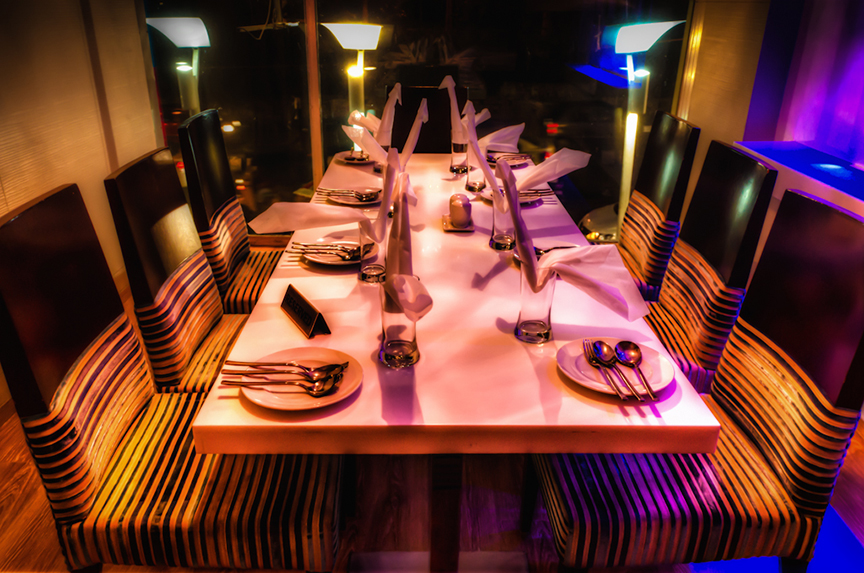
Photo courtesy Swastiverma.
High-end restaurants collaborate with residential buildings in major cities such as New York and Boston to create the ultimate experience for residents.
Waterline Square and Cipriani
Waterline Square has been designed by Rafael Viñoly Architects, Richard Meier & Partners Architects and Kohn Pedersen Fox Associates to create an iconic collection of luxury residential buildings on one of the last remaining waterfront development sites on the Upper West Side of Manhattan. The masterplan encompasses nearly five acres and will be located in Manhattan along the Hudson River from West 59th Street to West 61st Street where Midtown meets the Upper West Side.
Located within Two Waterline Square, designed by KPF, the groundbreaking development will be home to the first-ever experiential food market by the Cipriani family.
The Cipriani family will develop 28,000 square feet of space for a large-format culinary experience with multiple food and beverage establishments, including a market, restaurants and fast casual outlets. Martin Brudnizki, the internationally-acclaimed, London-based interior designer, will design the new Cipriani food hall.


Photos courtesy of Four Seasons Hotel & Private Residences One Dalton
Created and co-founded by acclaimed chef Rainer Becker, Zuma takes its inspiration from the informal and popular Japanese izakaya, where guests enjoy a relaxed dining and drinking style that uniquely embraces every element of Japanese cooking under one roof. Zuma takes this ideology, and in an elegant and contemporary environment, offers a modern Japanese dining experience that is authentic, but not traditional.
Developed by Carpenter & Company, the Four Seasons Hotel & Private Residences One Dalton Street, Boston, is slated to become New England’s tallest residential tower upon its completion. Designed by legendary architect Henry N. Cobb, in collaboration with Cambridge Seven Associates, the 742-foot tower will feature 160 luxury condominiums and the second Four Seasons hotel in Boston. Celebrated designer Thierry Despont has crafted custom interiors for the residential lobby and 50th floor Club Lounge.
30 Park Place and CUT by Wolfgang Puck
Located in Tribeca at the corner of Church Street and Park Place, 30 Park Place is the tallest condominium tower to grace the Downtown skyline at 926 feet, with panoramic views of Midtown Manhattan, the Hudson and East Rivers, the New York Harbor and Statue of Liberty.
30 Park Place is designed by celebrated architect, Robert A.M. Stern, developed by Silverstein Properties and offers 157 residences in a mix of one- to six-bedrooms. 30 Park Place also features nearly 40,000 square feet of amenities, as well as a full suite of hotel services, all managed by Four Seasons Hotels and Resorts.
The Four Seasons Hotel New York Downtown sits below the private residences at 30 Park Place. Occupying the first 24 floors of the tower and known for its five-star services, experiences and amenities, The Four Seasons Hotel New York Downtown is home to CUT by Wolfgang Puck, the celebrity chef and restaurateur’s first and only New York restaurant. Accessible through a secret door on the residents’ side of the building, 30 Park Place owners never have to leave the building to dine at Puck’s restaurant.
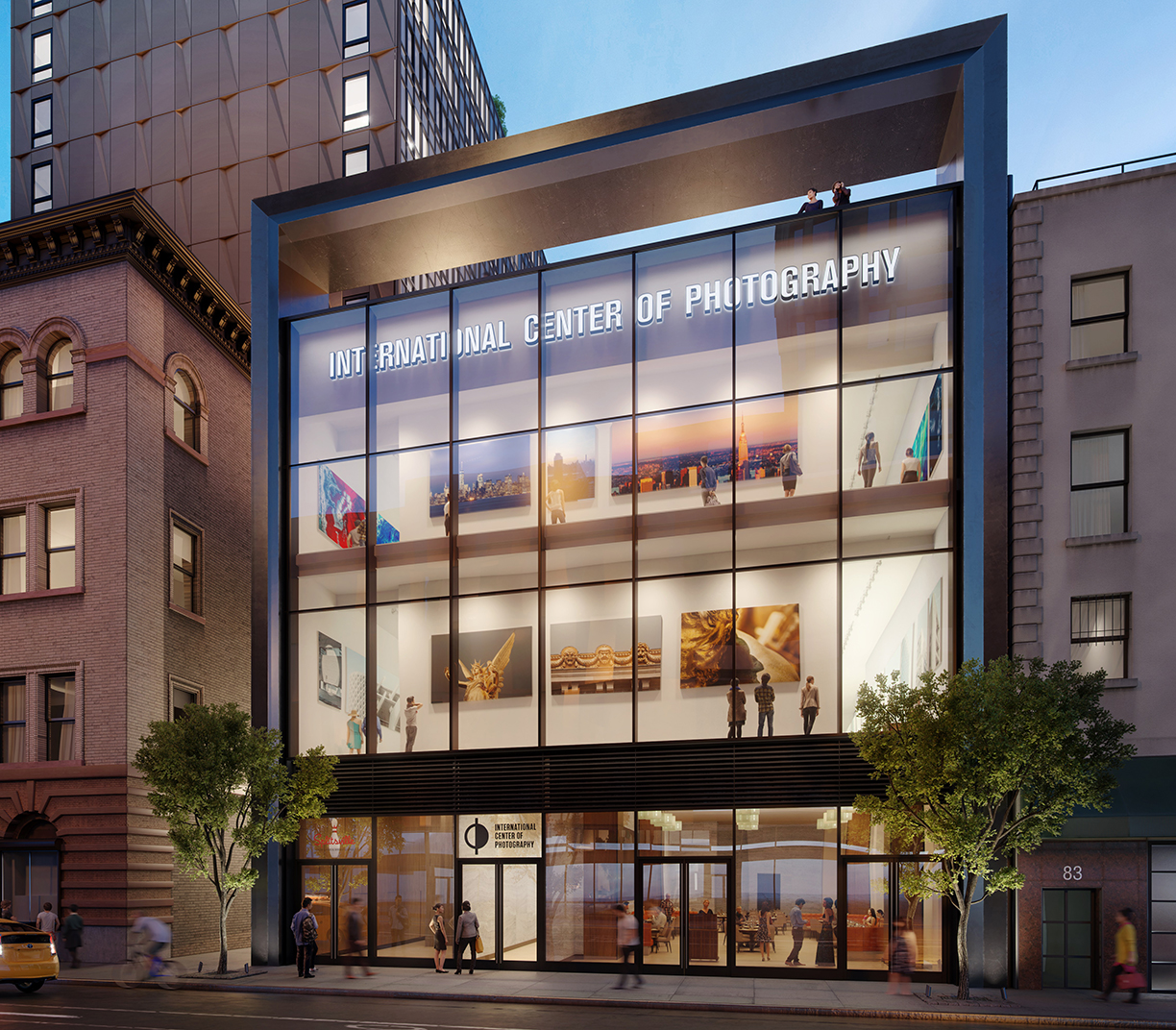
Photo courtesy of Moso Studio
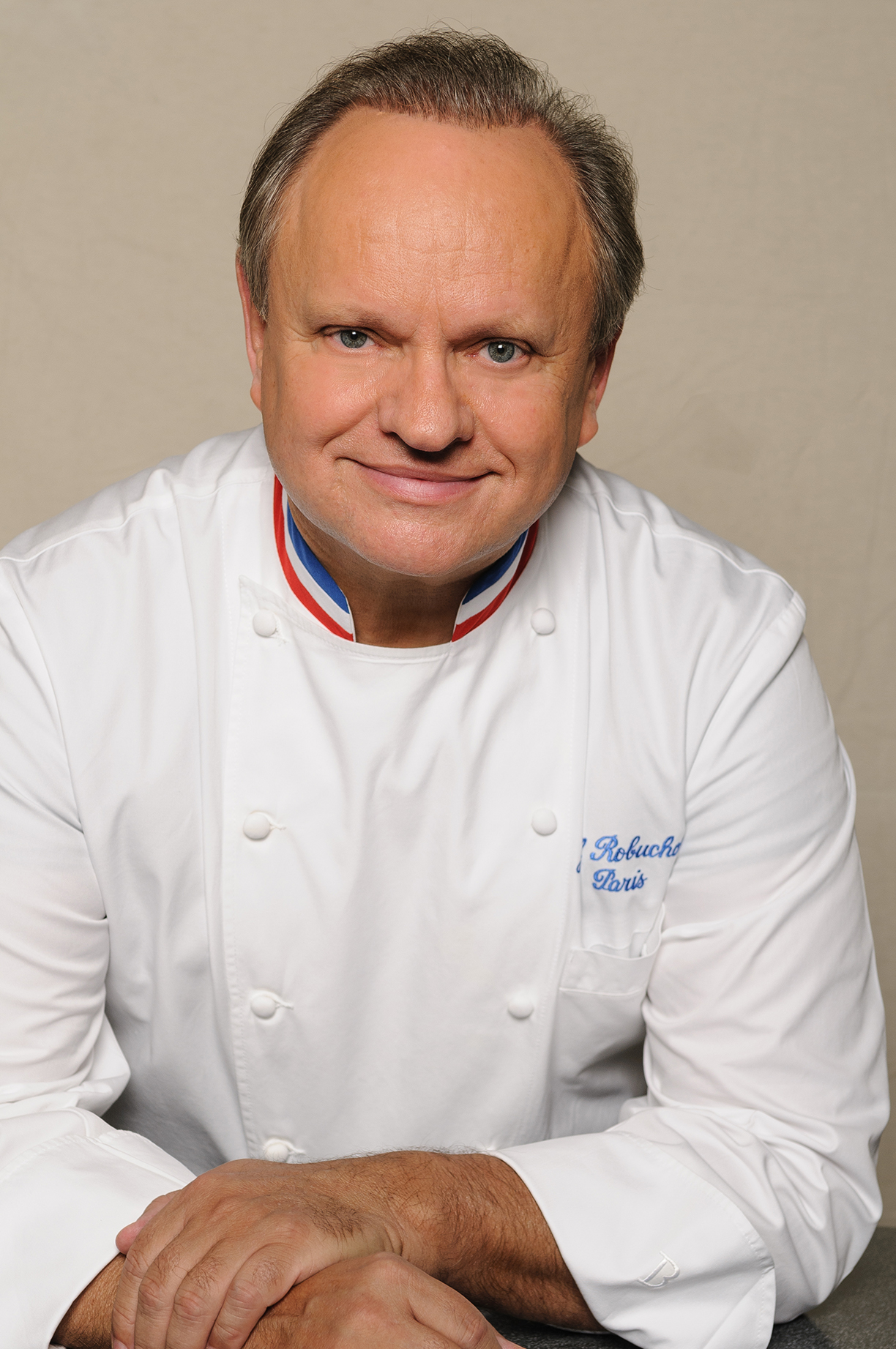
Photo courtesy of Joël Robuchon


Photos courtesy of Noe & Associates with The Boundary
Four Seasons Hotel & Private Residences and Zuma
Four Seasons Hotel & Private Residences, One Dalton Street, Boston has announced its partnership with internationally acclaimed celebrity-studded restaurant group, Zuma, which will offer world-class cuisine to One Dalton residents, hotel guests and locals alike in early 2019. The Boston location marks the company’s first collaboration with Four Seasons Hotels & Resorts and its fourth location in the United States — part of a successful expansion into the American market.
The restaurant will showcase bold flavors and simple presentation combined with an environment of sophisticated and stellar service. Zuma will bring its signature culinary approach with a touch of local flavor to Four Seasons Hotels & Resorts’ upcoming Boston location, which will be located on the third floor of One Dalton and designed by Noriyoshi Muramatsu of Tokyo-based Studio Glitt.
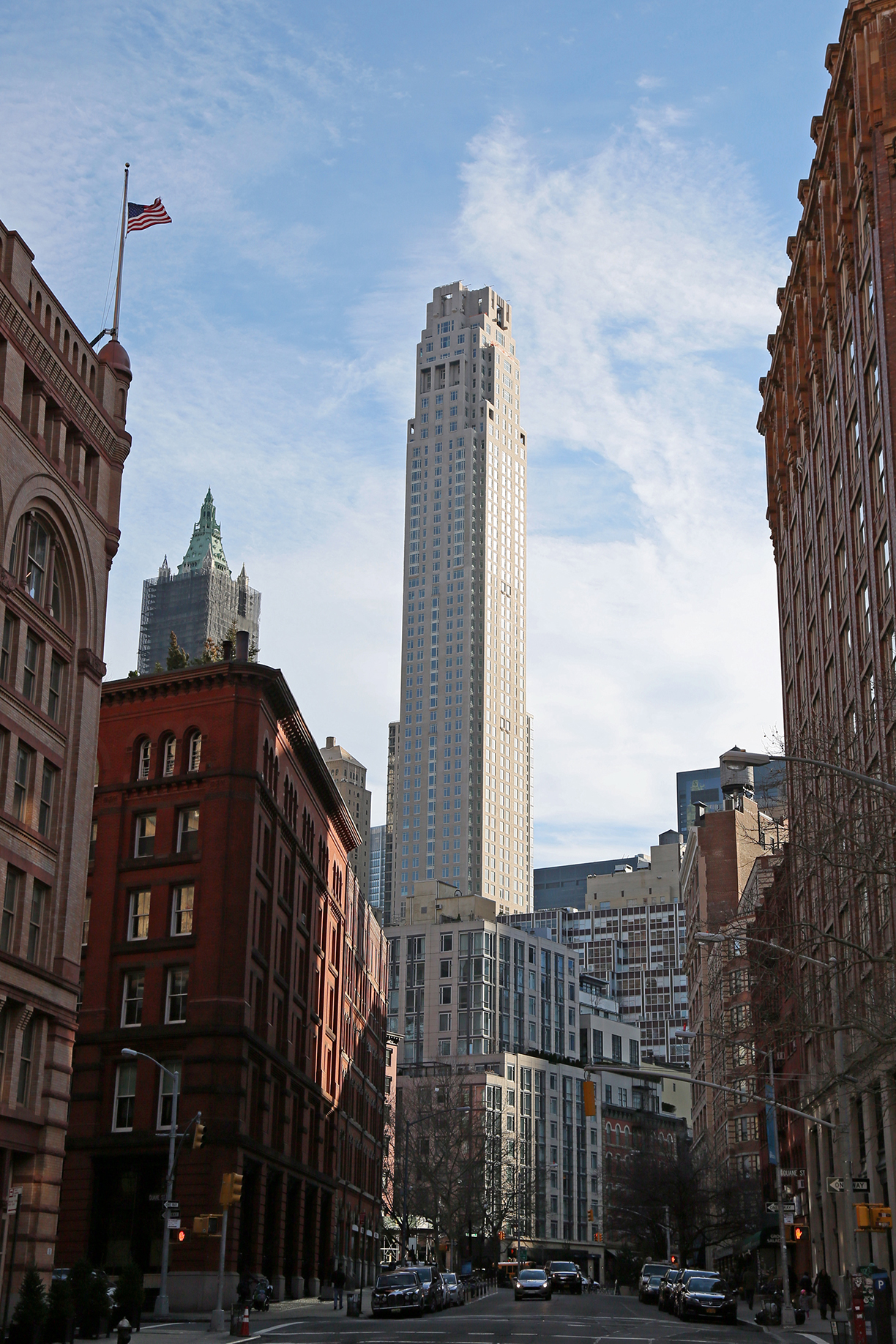
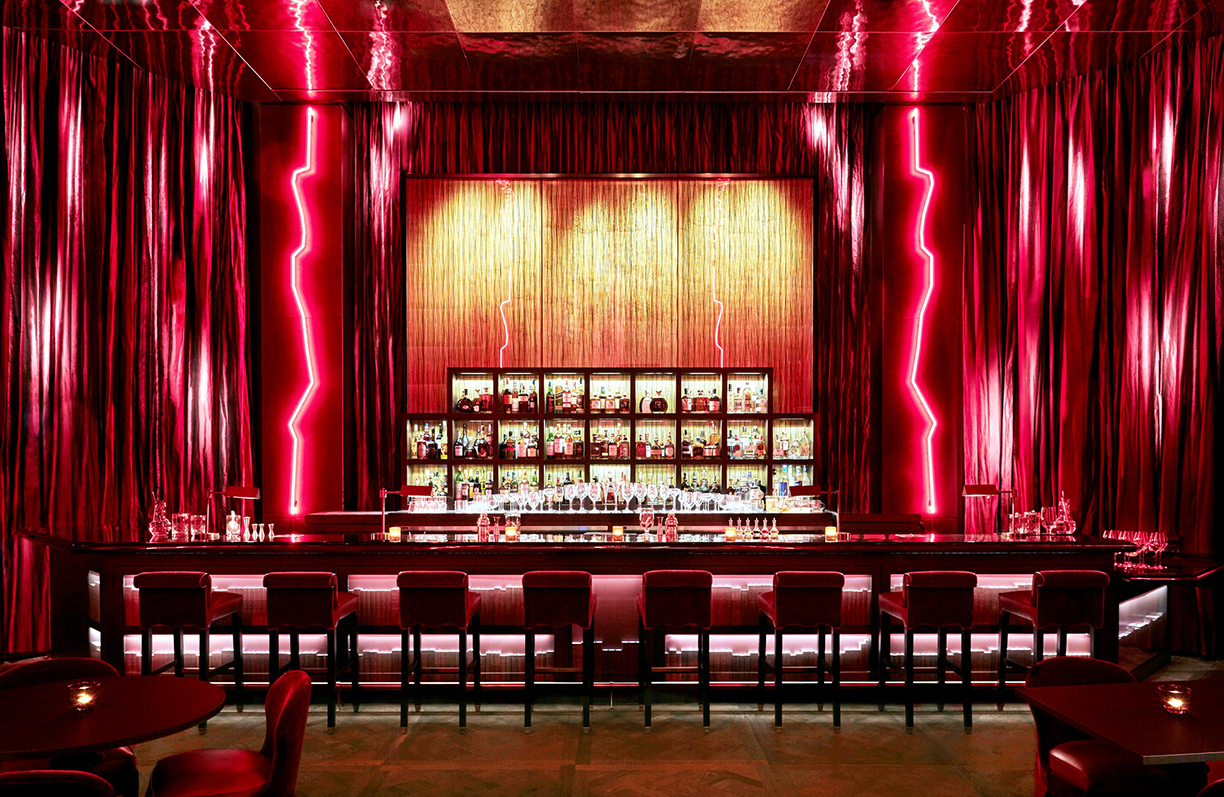
Photos courtesy of 30 Park Place
242 Broome and Make It Nice
242 Broome is the first condominium within Essex Crossing, a planned mixed-use development comprising residential, office, retail, cultural and community space on Manhattan’s Lower East Side. The 14-story, 55-unit luxury building designed by SHoP Architects will also be the new home of the International Center of Photography, which will feature an event space run by Make It Nice — the hospitality group from Eleven Madison Park.
The co-owners of Make It Nice, Will Guidara and Daniel Humm, continue to transform the world of dining with their critically acclaimed restaurant Eleven Madison Park, which is currently rated the best restaurant in the world on The World’s 50 Best Restaurants list, possesses three Michelin stars and received a four star review from The New York Times in 2015. The pair’s Make It Nice hospitality group also oversees the food and beverage spaces at The NoMad hotels in New York and Los Angeles in addition to Made Nice in The NoMad where seasonal dishes are served in an elevated counter service environment.
Make It Nice’s collaboration with ICP marks its first off-site partnership. Guests attending events in the dramatic bi-level space on the top floors of ICP can expect the same outstanding hospitality and exquisite food intrinsic to these distinguished restaurants.
One Hundred East Fifty Third Street and Joël Robuchon
Soaring 63 stories with a collection of 94 contemporary homes, One Hundred East Fifty Third Street is a striking new modernist architectural landmark from Foster + Partners, which offers the highest level of lifestyle services and comfort. Residents at One Hundred East Fifty Third Street will enjoy the distinct privilege of sharing their address with a restaurant by Joël Robuchon, the world’s most decorated Michelin-starred chef. The tower is anchored by a soaring bi-level space designed by Joseph Dirand that will feature two highly anticipated dining concepts slated to open this year. Residents will receive preferred access to these restaurants as well as in-home dining options.
“We are thrilled to partner with Joël Robuchon and Aby Rosen on this exceptional project,” said Alex Gaudelet, CEO of Invest Hospitality. “The combination of the chef with the most Michelin Stars in the world and one of New York’s most audacious visionaries is going to make for an iconic venue.”
In addition, the building offers super luxe, spa-inspired amenities designed by AD-100 designer William T. Georgis. They include a 60-foot sunlit swimming pool, a cardio room, weight room, pilates/ballet room, yoga room, sauna, steam room, spa treatment rooms and his-and-her changing rooms and showers.
Residences at One Hundred East Fifty Third Street are a mix of tower-style units with skyline views and a specialized collection of loft residences on the bottom floors, which feature concrete walls and floors and are specifically designed to accommodate large art collections. Pricing for available units in the building begins at $2.3 million for a studio, and go up to $65 million for the 6,760-square-foot penthouse.
American chefs appreciate French tradition, but are increasingly inspired by ethnic communities in their own backyards.
By Roger Grody
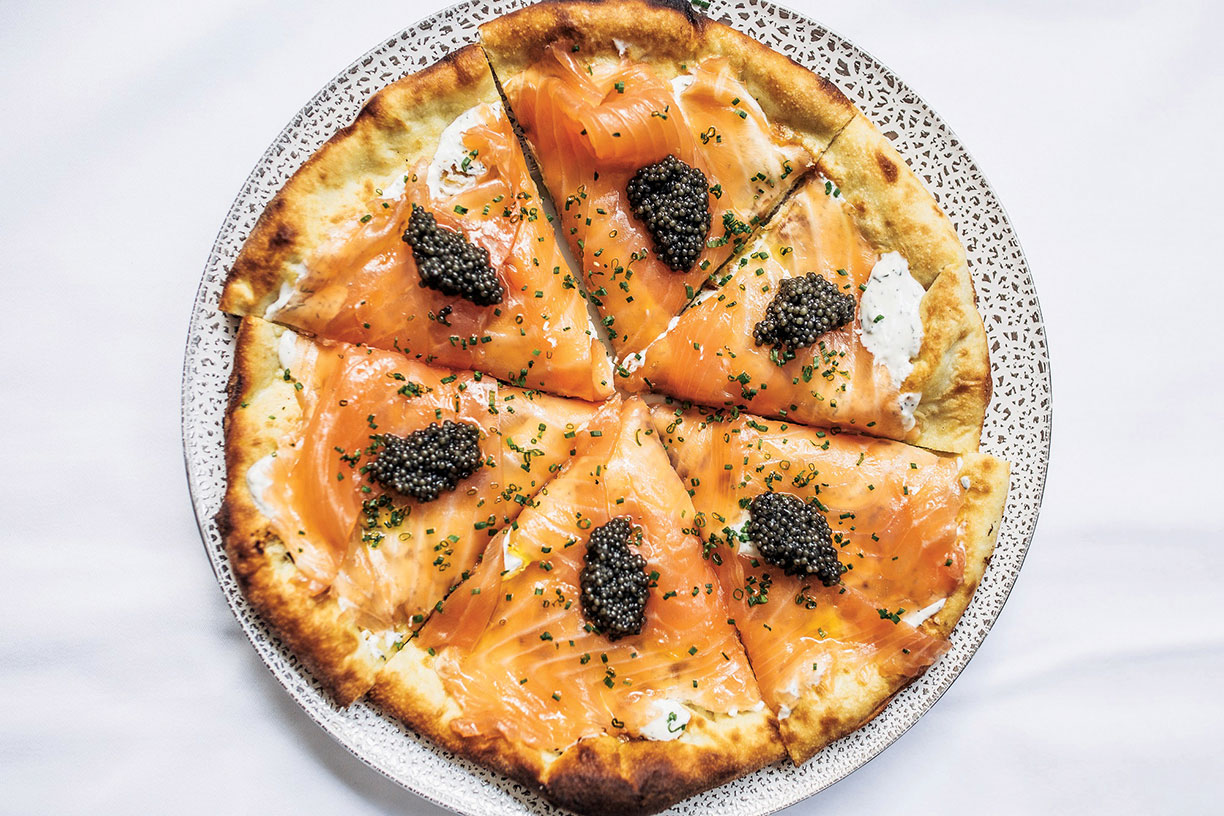
Photo courtesy Antonio Diaz
There was a time when young chefs in America were primarily influenced by French masters like Paul Bocuse or Joël Robuchon. While classic technique remains important, eclectic global flavors have become equally influential. Conveniently, chefs no longer need to travel the world to discover exotic fare, because it is simmering in the diverse ethnic neighborhoods of most American cities.
The practice of incorporating ethnic elements into familiar dishes used to be referred to as “fusion,” a term that has fallen out of favor with contemporary chefs, and today’s cross-cultural combinations are more nuanced and less frivolous than in the 1980s. Today, chefs tend to use local ethnic cuisines as accents or pay tribute to their own families’ immigrant roots. The presence of Middle Eastern falafel on a French menu or a dusting of Japanese togarashi seasoning on potatoes at an all-American steakhouse does not compromise the integrity of their respective cuisines, but certainly makes them more interesting.
A master of infusing local ethnic flavors into his dishes is celebrity chef José Andrés, who borrows Latin American and Asian elements at The Bazaar by José Andrés in Los Angeles. In multicultural Miami, he incorporates Caribbean elements into his menu at The Bazaar South Beach. Given his own Spanish heritage, incredible versatility and expertise with complex molecular gastronomy techniques, most Andrés menus feature some unusual culinary mashups.
At South Beach, Andrés honors the local Cuban community with colada Cubana, a play on Cuban coffee turbocharged with foie gras, and pollo al ajillo (garlic chicken) slow-cooked with black garlic. As a tribute to South Florida’s Jewish community — largely comprised of transplanted New Yorkers — the chef offers a clever riff on bagels and lox: dill cream cheese-filled bagel cones topped with salmon roe. And for dessert, Andrés playfully deconstructs another local specialty, Key lime pie.
Bazaar South Beach chef de cuisine Tito Vargas, a native of Puerto Rico, says he and Andrés draw inspiration from a wide variety of Latin American and Caribbean cultures. “It’s important that I keep true to José’s vision, showcasing the main ingredient and transforming it without sacrificing the flavor and integrity of the product,” he says. Vargas notes that even when applying high-tech culinary tricks, the essence of a dish is respected and preserved. “In no way, shape or form does it look like a Cuban sandwich, but when you bite into it you get all the flavors that compose a Cuban sandwich in a more fun, inventive way,” says the chef of The Bazaar’s molecular gastronomic version.
Despite Los Angeles’ reputation as a bland, immense swath of suburbia, its location — on both the Pacific Rim and threshold to Latin America — ensures diverse ethnic communities that constantly fuel the imagination of local chefs. In L.A., where California Cuisine has morphed into a more global fare, crossing culinary borders is almost routine. At Wolfgang Puck’s celebrity-favored Spago in Beverly Hills, for instance, the menu includes elements from nearly a dozen cuisines.
Bryant Ng was trained in classic French cuisine — he cooked with celebrated chef Daniel Boulud in New York — but at his own restaurant, Cassia in Santa Monica, California, he cooks French brasserie fare with an ethnic twist. At first glance, Cassia’s menu looks like it was borrowed from a Parisian brasserie, but the young chef tweaks traditional dishes with accents from his father’s Singaporean roots and his wife’s Vietnamese heritage.
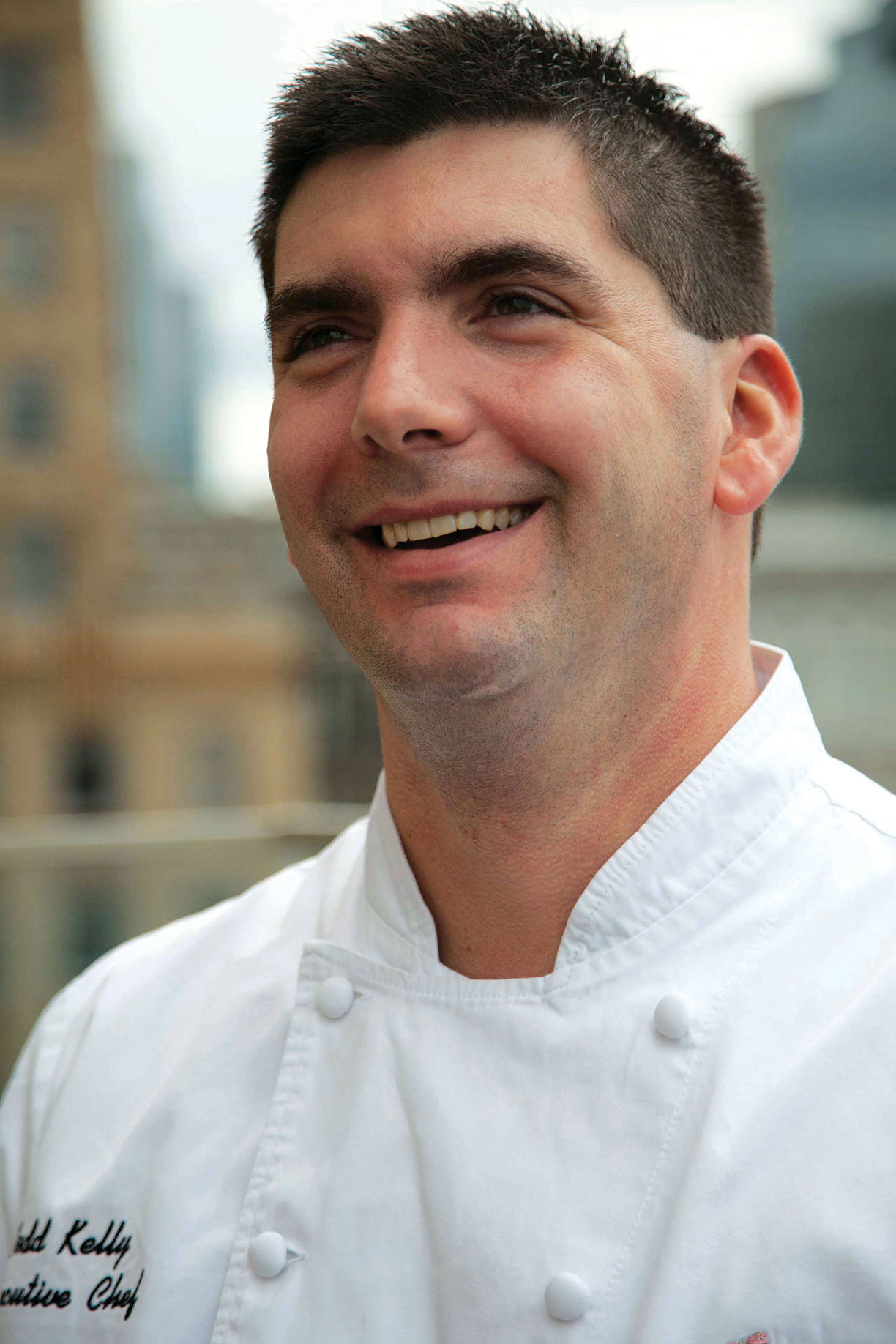
Todd Kelly
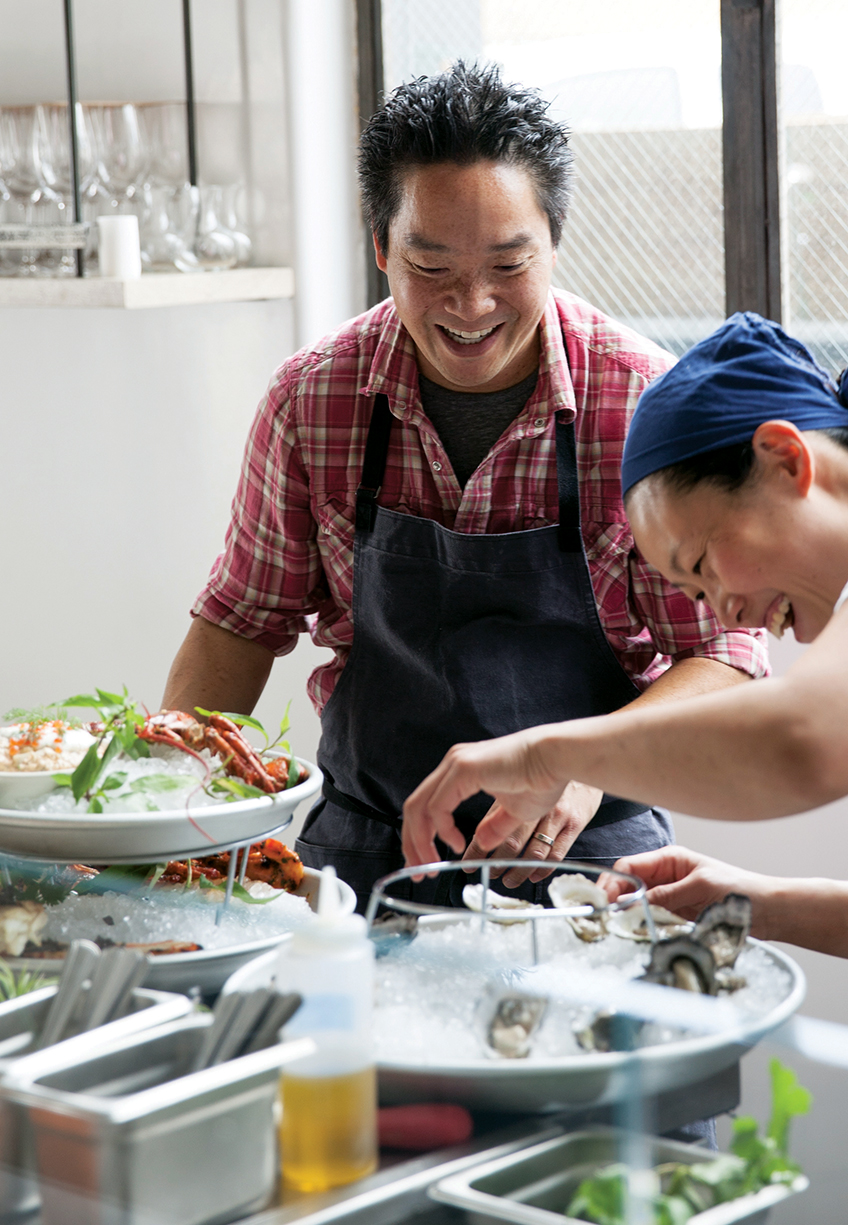
Bryant Nig
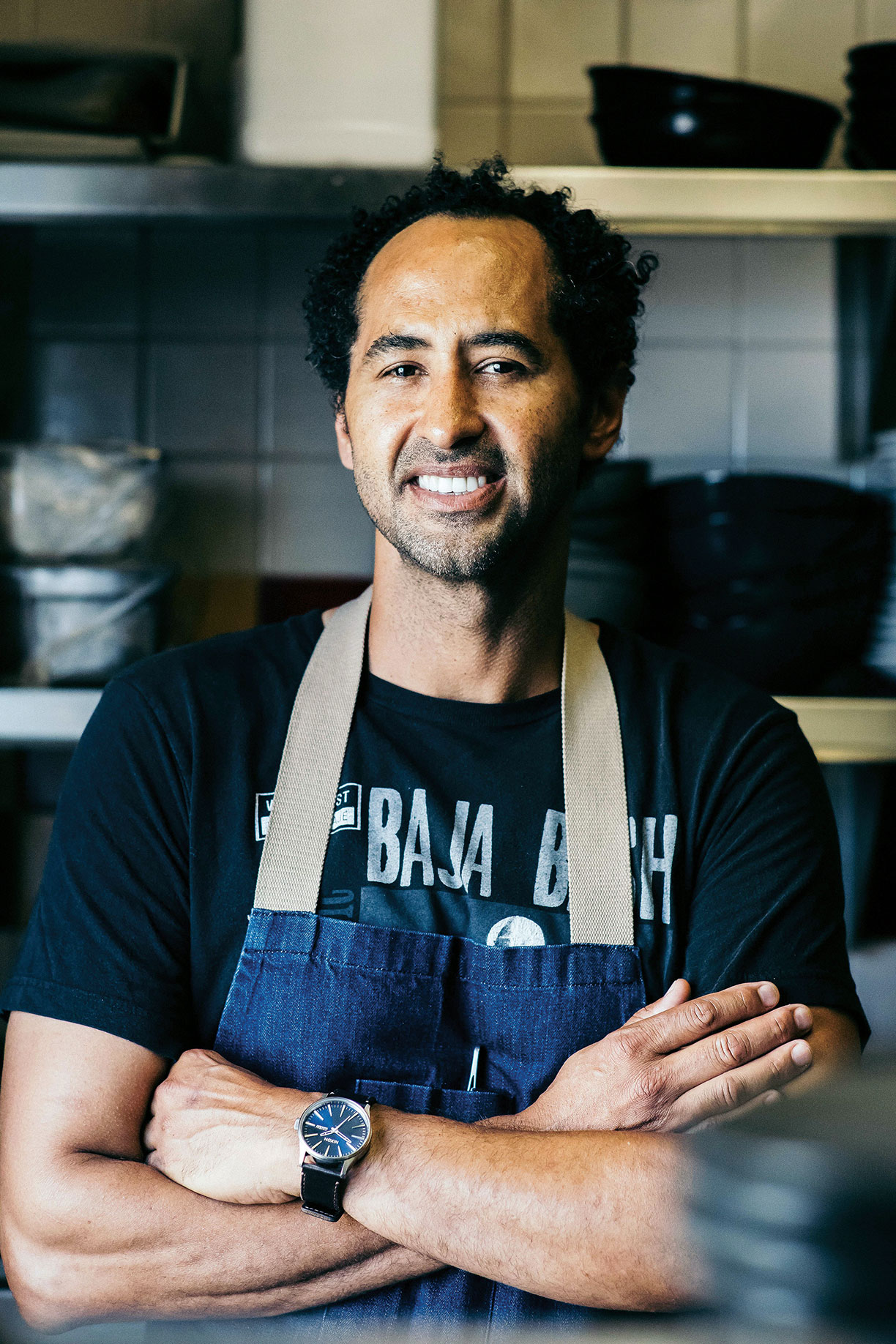
Jason Nibb
Ng’s charcuterie platter includes items like Singaporean candied pork and Vietnamese meatloaf, while escargots are scented with lemongrass. Cassia’s take on the French comfort dish of pot-au-feu has a pho-inspired broth and the bistro staple of steak frites is bathed in a Phú Quôc Island peppercorn sauce. Kaya toast, a signature of Singapore’s street vendors, is not likely to be found in a 14th arrondissement brasserie, but is a specialty at Cassia.
“It’s a very personal menu because it combines the food of my heritage, but also has influences from my professional experiences,” explains Ng. “Understanding the ‘soul’ of a cuisine is the greatest challenge,” says the chef, who dismisses the practice of simply adding a single indigenous ingredient. “Trying to incorporate multiple culinary influences requires a lot of self-editing and discipline,” adds Ng, who believes any composition must respect the referenced cultures.
Anita Lo is one of New York’s most honored chefs and her restaurant Annisa is a reflection of the diverse influences inherent in contemporary American cuisine. A second-generation Chinese-American, Lo’s passion for food can be traced to Paris, where she first fell in love with the art of cooking. She polished her skills in revered French kitchens and classic technique has always been essential to her approach.
At her Manhattan restaurant, those French sensibilities are applied to some ingredients from her own family’s heritage, as well as other global influences discovered in New York’s rich patchwork of ethnic neighborhoods. Since Annisa’s opening in 2000, Chinese dumplings filled with foie gras mousse and jicama have been one of Lo’s signature dishes. A Chinese-French mashup way too cool to be called “fusion,” the dumplings are topped with seared foie gras and a beguiling black vinegar reduction.
At Orchids at Palm Court, an opulent dining room in the Art Deco Hilton Cincinnati Netherland Plaza, executive chef Todd Kelly is contributing to getting the food scene of the Midwest — a region often neglected outside of Chicago — noticed. As a boy, the native New Yorker lived in Mauritius, an island in the Indian Ocean near Madagascar, and that experience, as well as the chef’s naturally curious palate, results in a menu with eclectic influences.
Kelly’s cuisine, built on a solid classical foundation, is laced with intriguing ingredients like Buddha’s hand, lemongrass, paneer, and sudachi. He is adept at making familiar preparations suddenly exciting without excessively altering their essence. For example, a dash of harissa (a spicy North African chili paste) gives a dish of white asparagus with traditional French velouté sauce some zing, while red snapper en papillote, a characteristically South of France preparation, receives an exotic Indian accent with vadouvan curry.
“I like to pull in flavors from my past or things I really crave,” says Kelly, noting that the cultural melting pot of Mauritius and ethnic neighbors on Long Island both contributed to his culinary wanderlust. Recently, the chef has been experimenting with Indian ingredients like nigella, fenugreek and mango powder, insisting they need not distract from the classical roots of a recipe. “The lesson is all about balance and learning that sometimes it’s the simplicity and restraint that controls a dish,” says Kelly.
In La Jolla, San Diego’s chic oceanfront district, executive chef Jason Knibb is known for his molecular gastronomy and globetrotting flavors at Nine-Ten Restaurant & Bar, which celebrates the Golden State’s finest seasonal ingredients. His Jamaican heritage may account for the jerk-seasoned pork belly on the chef’s menu, but his ethnic influences also extend to Latin American, Japanese and Middle Eastern traditions.
“San Diego is a tapestry of rich ethnic diversity, and the local food scene is no exception,” says Knibb. “There are so many chefs who have come to town from other regions bringing their own ethnic influences,” he adds, and makes a point to experience their cuisines firsthand. As a young chef in San Francisco, Knibb lived next door to a quick-service Mediterranean restaurant, and says, “They had some of the best falafels I’ve ever had … I still crave them today.” That unpretentious Mission District eatery was the inspiration for Nine-Ten’s spice-roasted carrots and carrot falafel with harissa yogurt and carrot hummus.
The recently announced James Beard Awards — the Oscars of the restaurant business — reflect a renewed respect for ethnic inspirations. The big winners were Israeli-American chef Michael Solomonov of Philadelphia’s Zahav and Chicago’s Topolobampo, where celebrity chef/restaurateur Rick Bayless is energized by his frequent travels to Mexico.
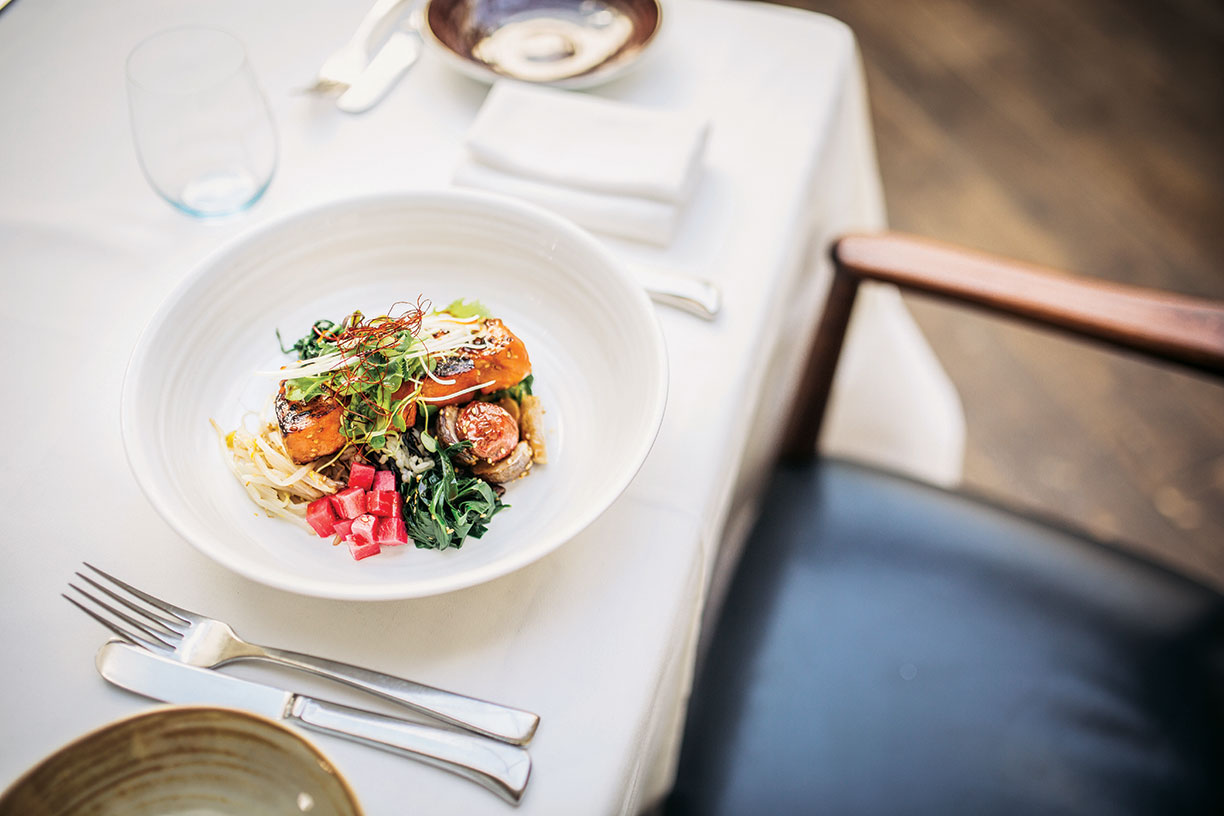
Photo courtesy Antonio Diaz
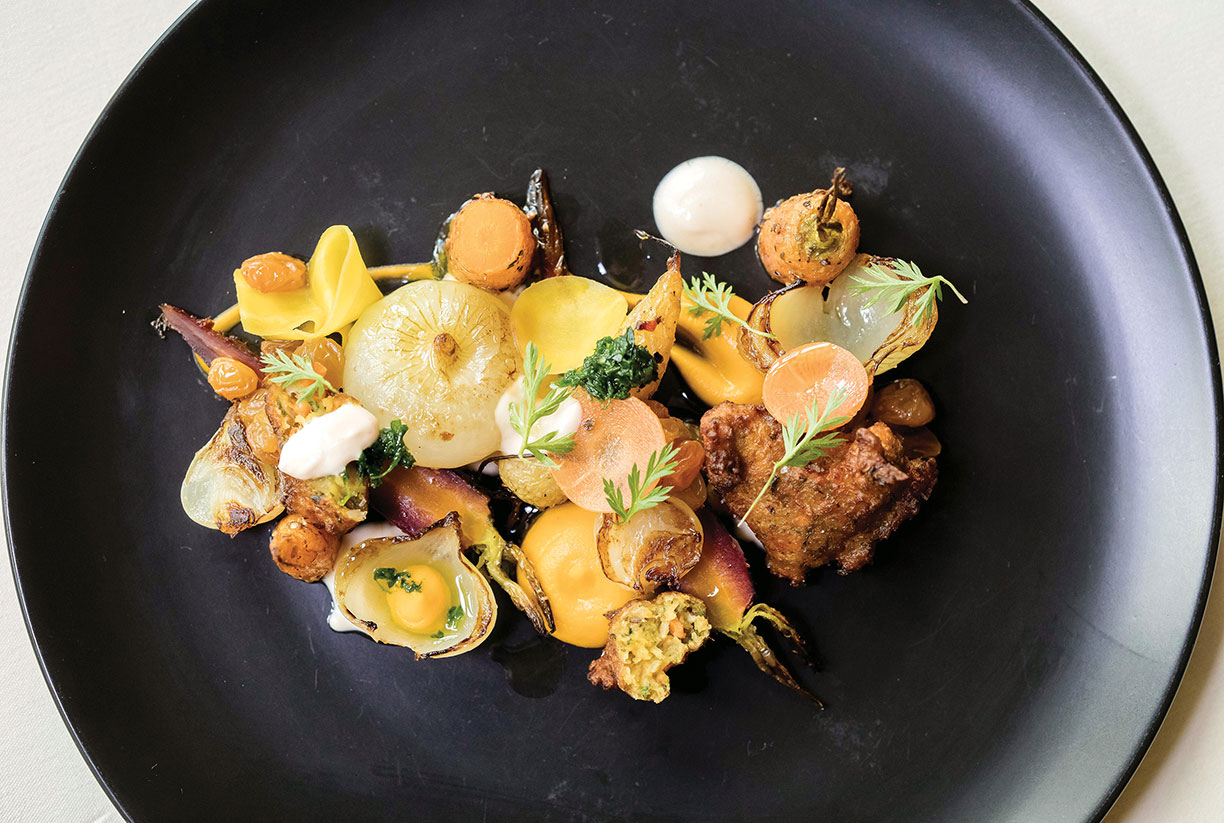
Photo courtesy Jason Knibb
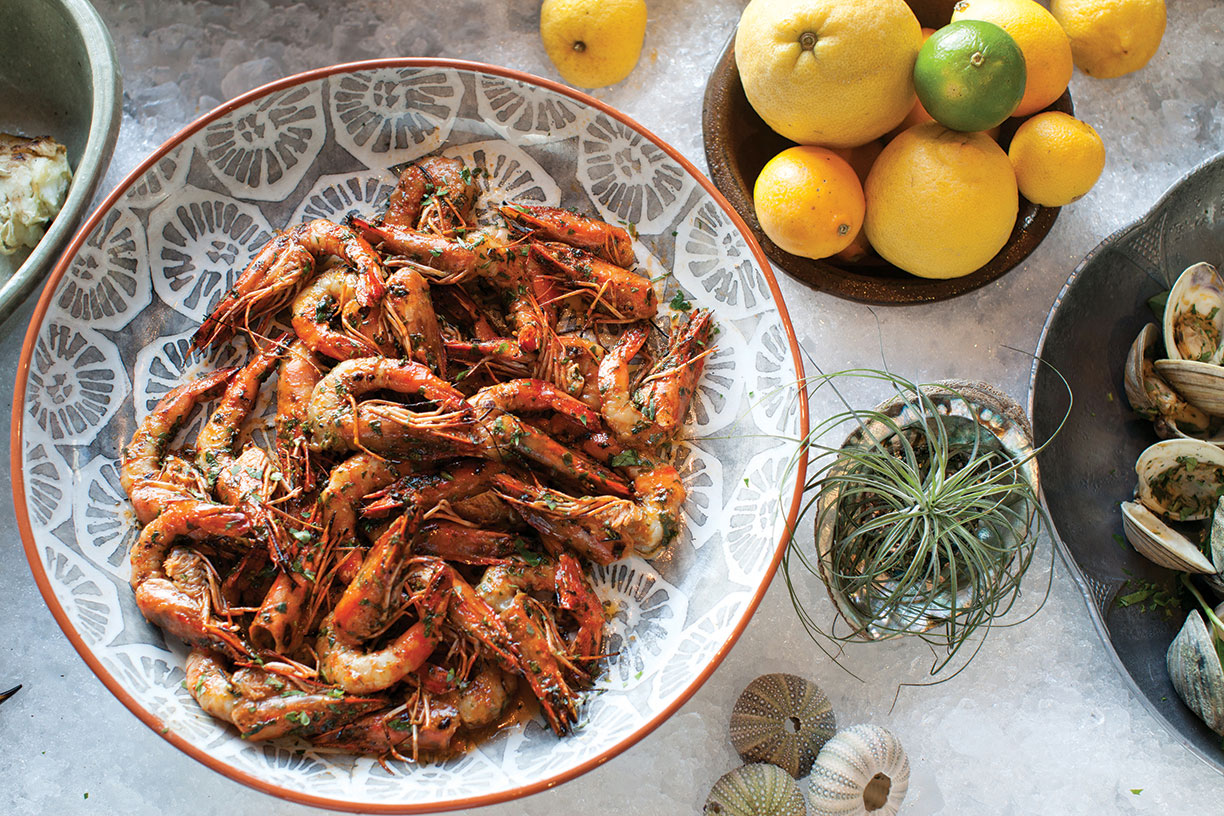
Photo courtesy Rick Poon
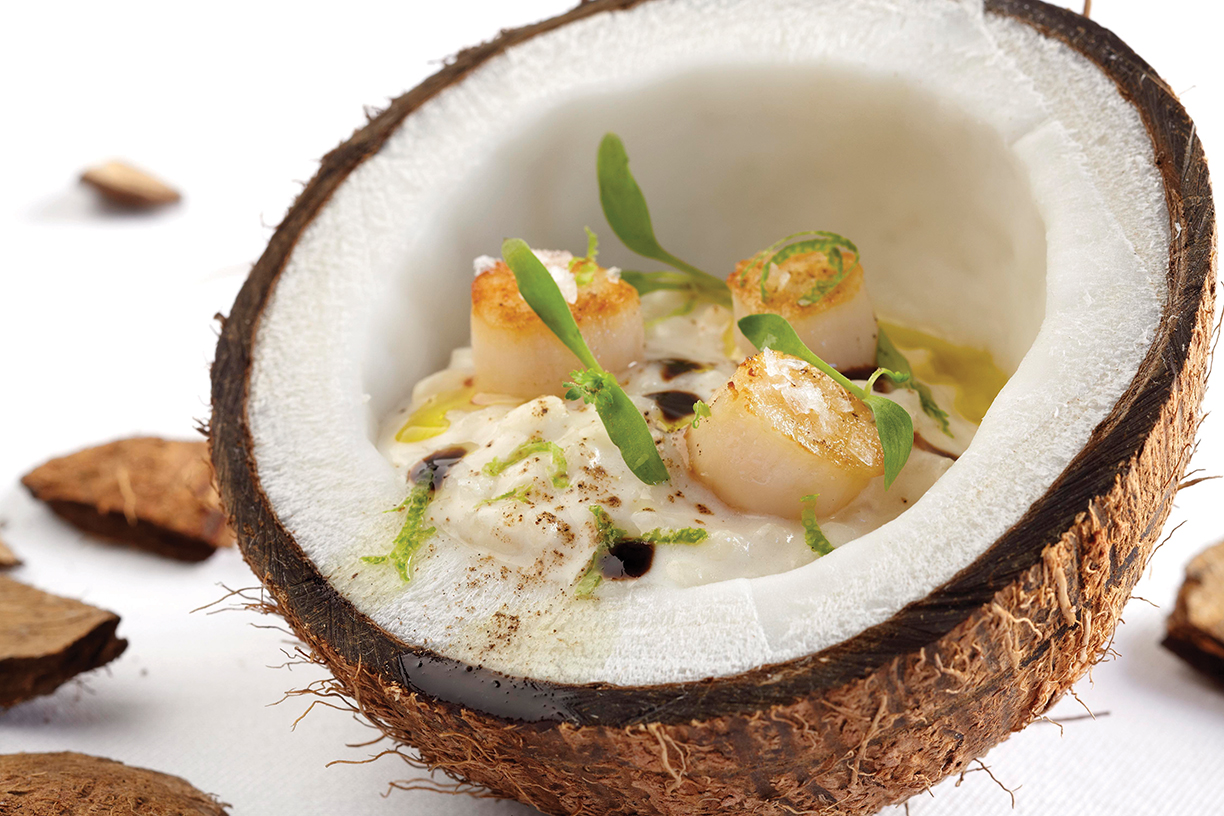
Photo courtesy Greg Powers Photography
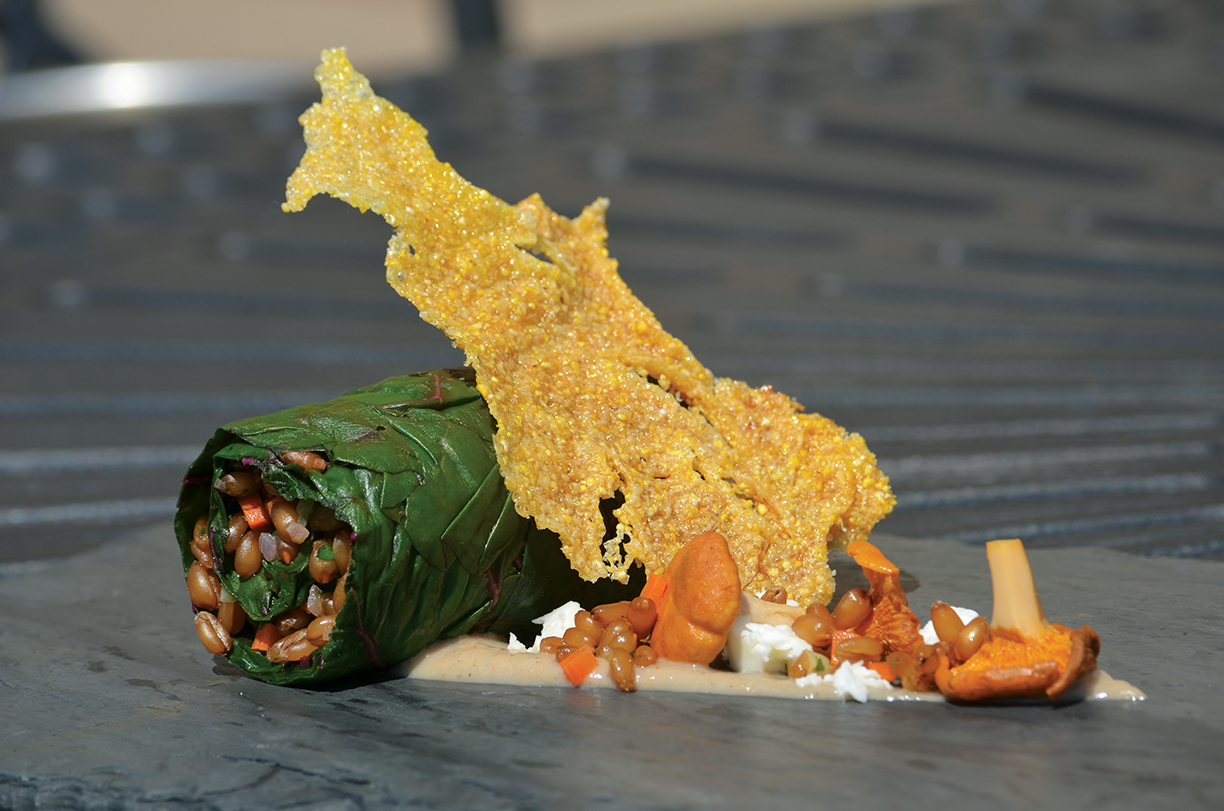
Photo courtesy Todd Kelly
Global Influences
Annisa, New York; www.annisarestaurant.com
The Bazaar by José Andrés, Los Angeles; www.sbe.com
The Bazaar by José Andrés South Beach; www.sbe.com
Cassia, Santa Monica; www.cassiala.com
Orchids at the Palm Court, Cincinnati; www.orchidsatpalmcourt.com
Nine-Ten Restaurant & Bar, San Diego; www.nine-ten.com
Spago, Beverly Hills; www.wolfgangpuck.com
Topolobambpo, Chicago; www.rickbayless.com
Zahav, Philadelphia; www.zahavrestaurant.com














